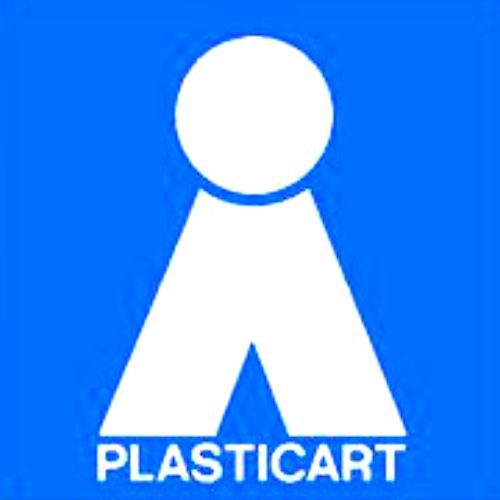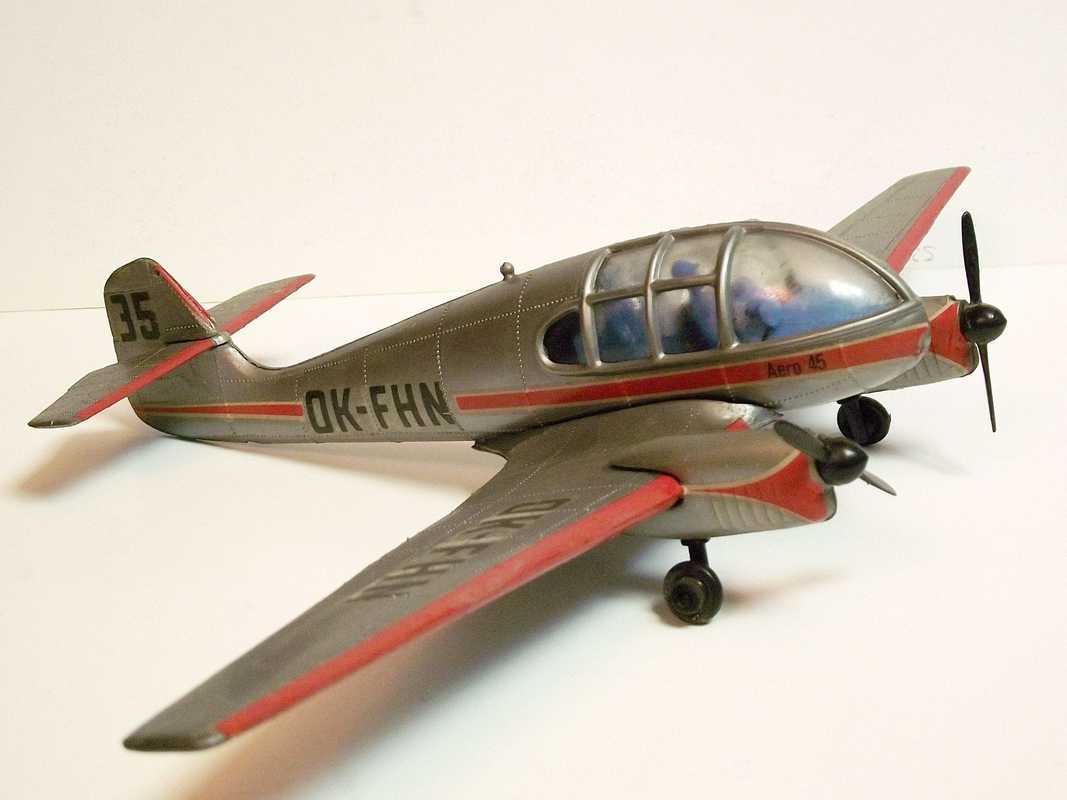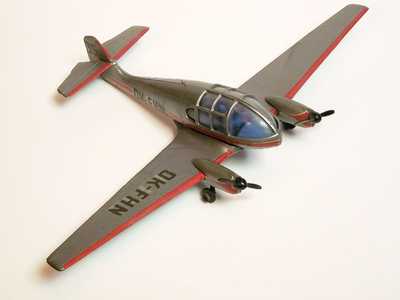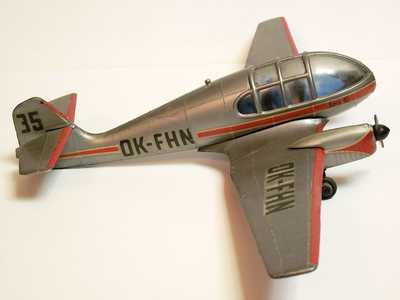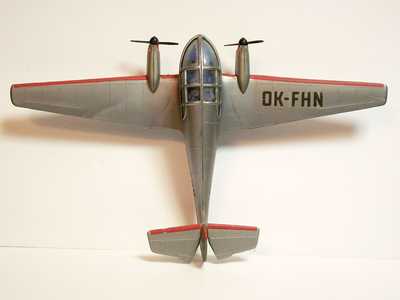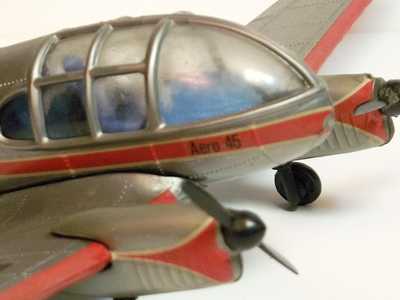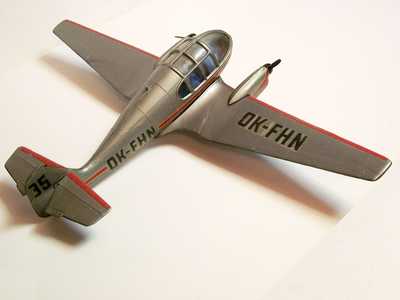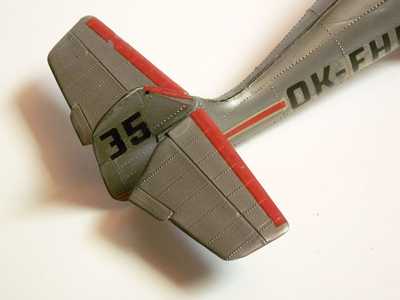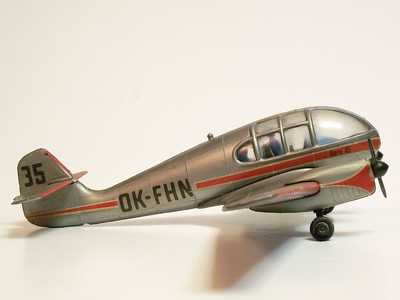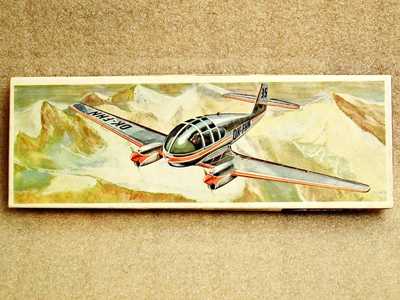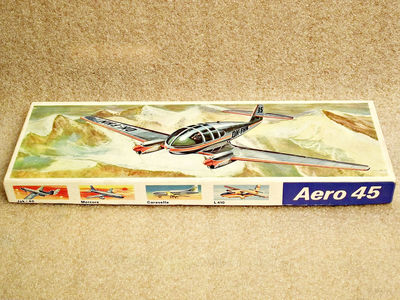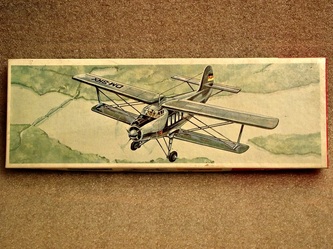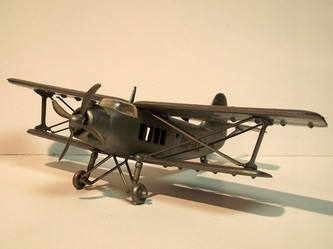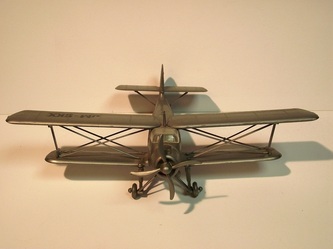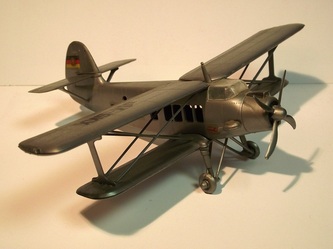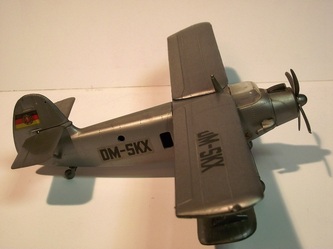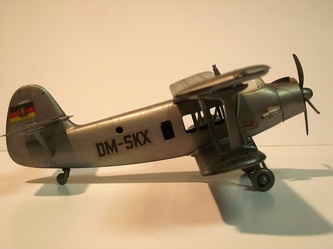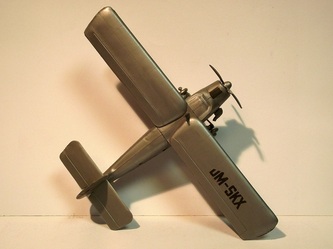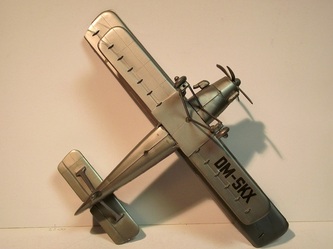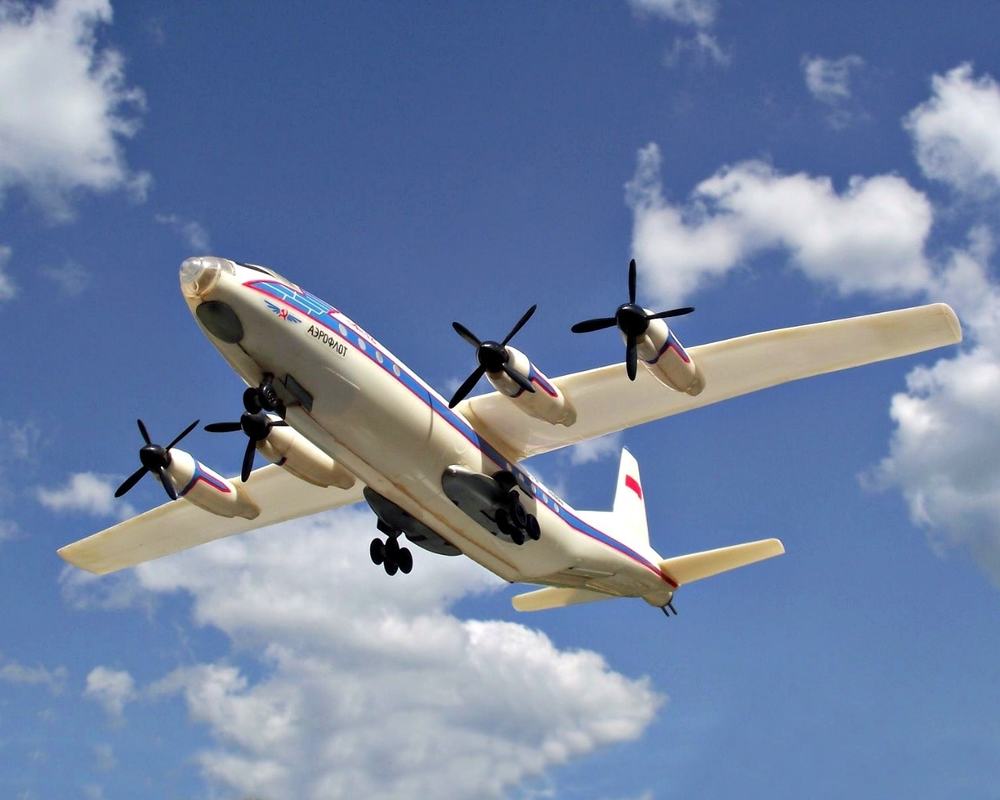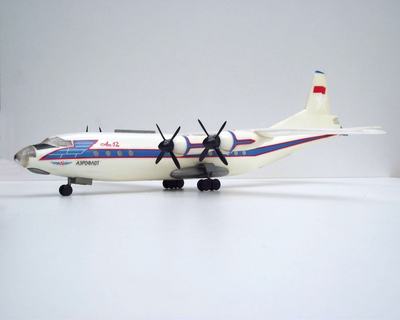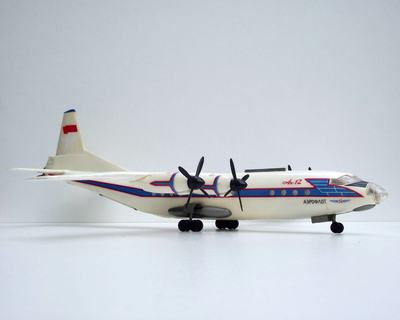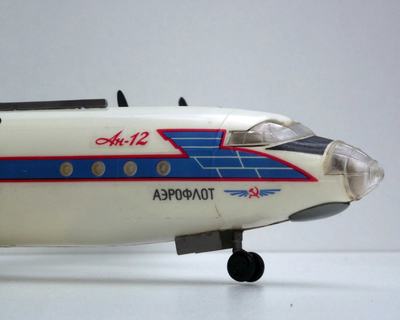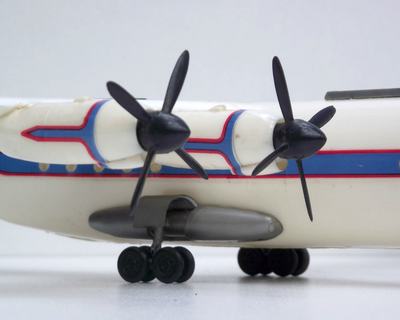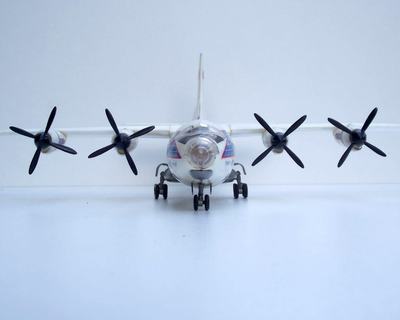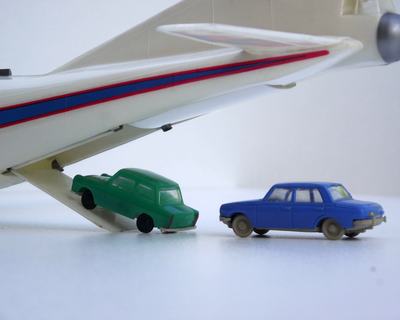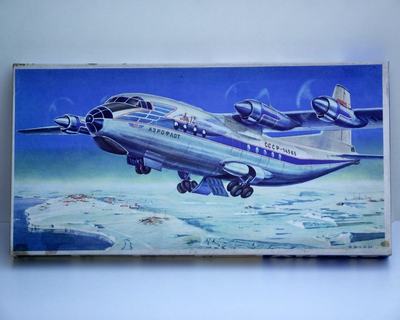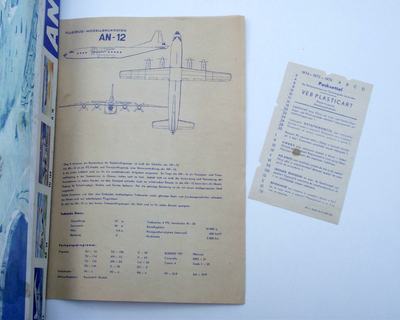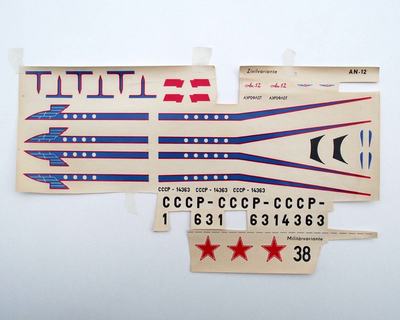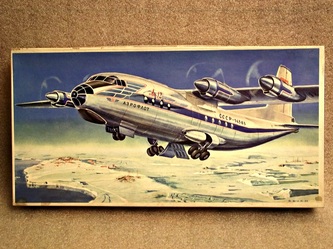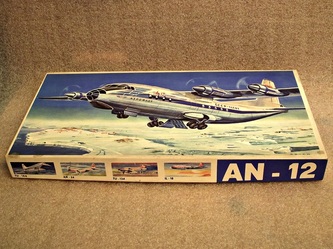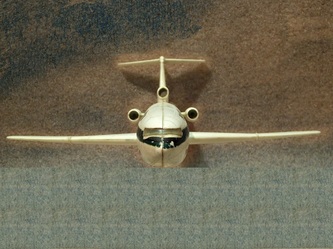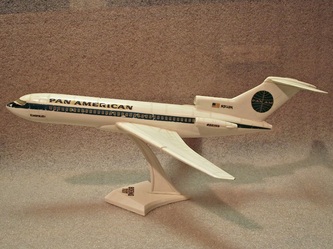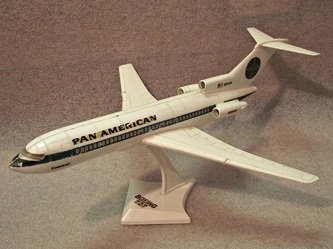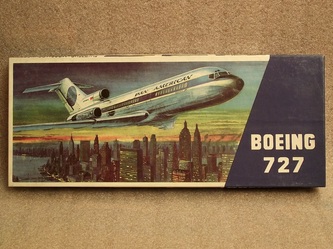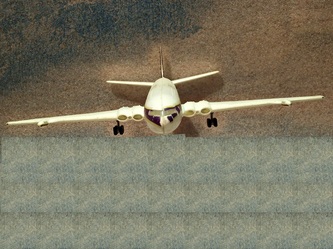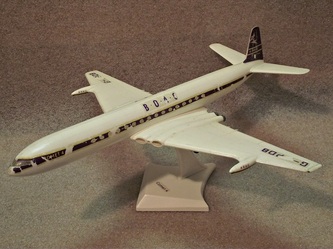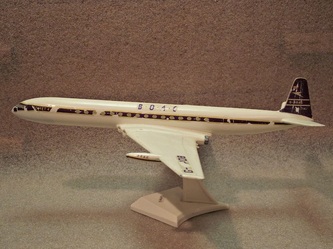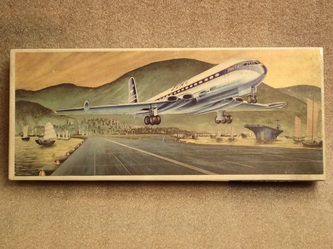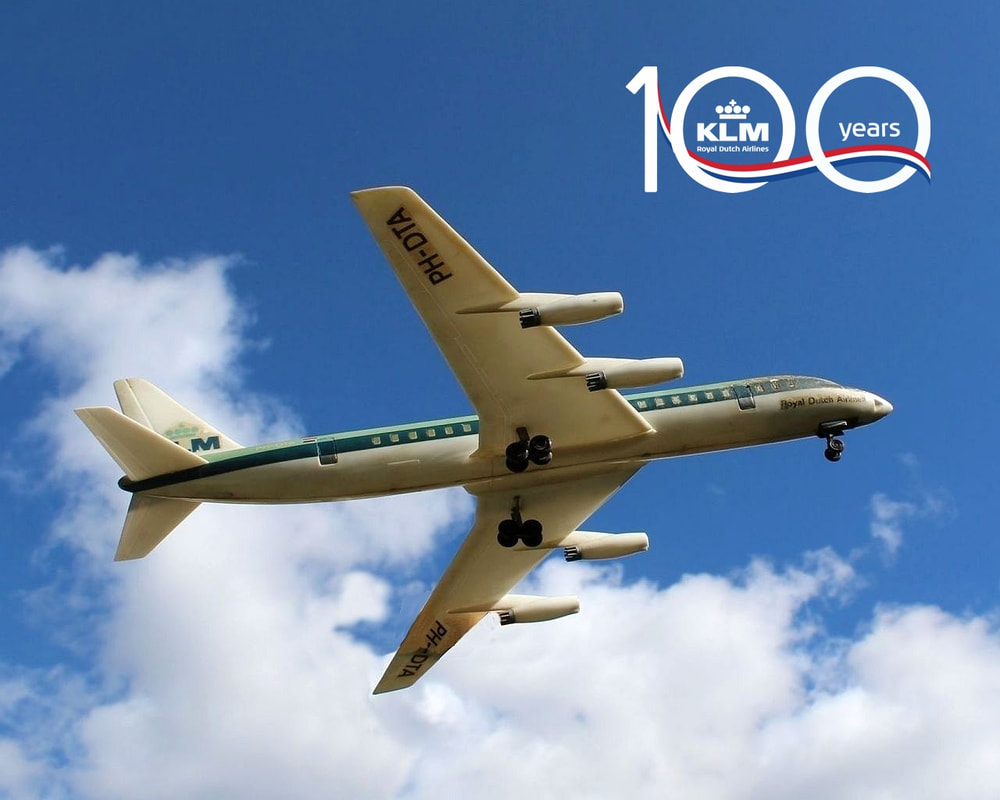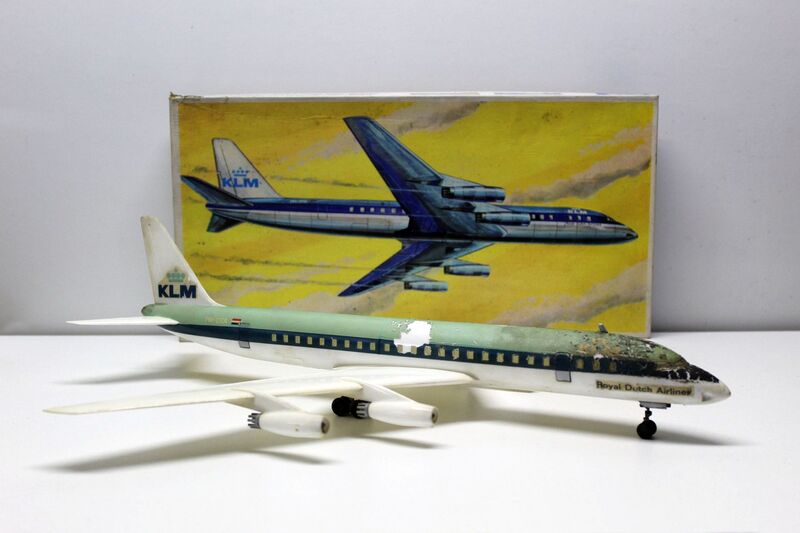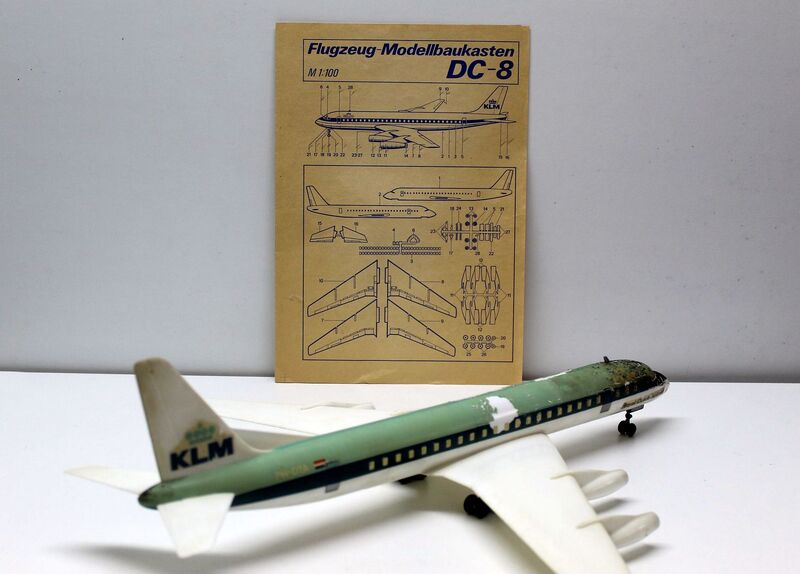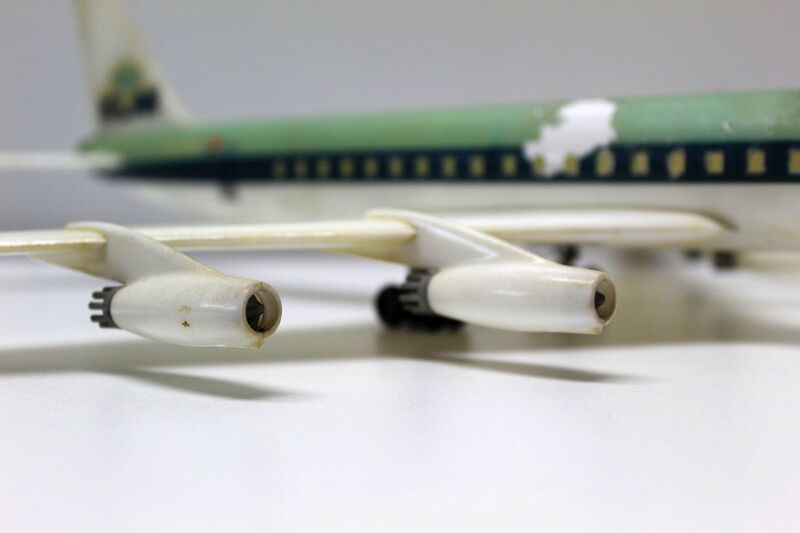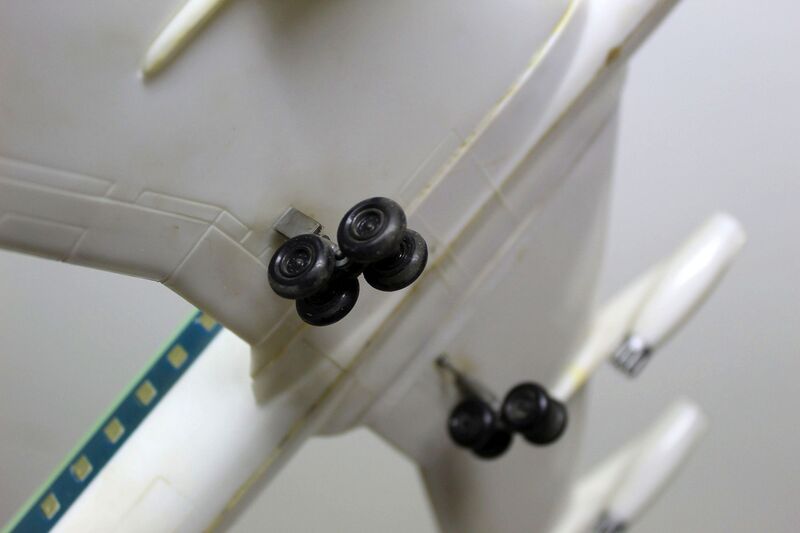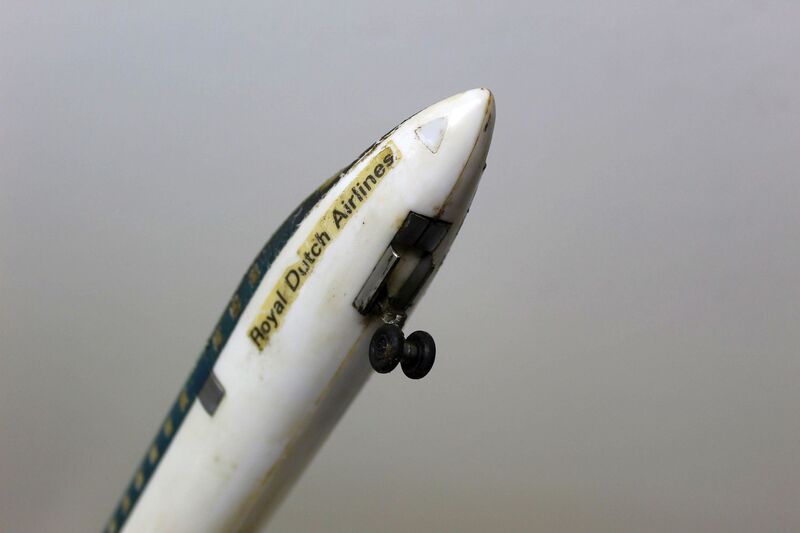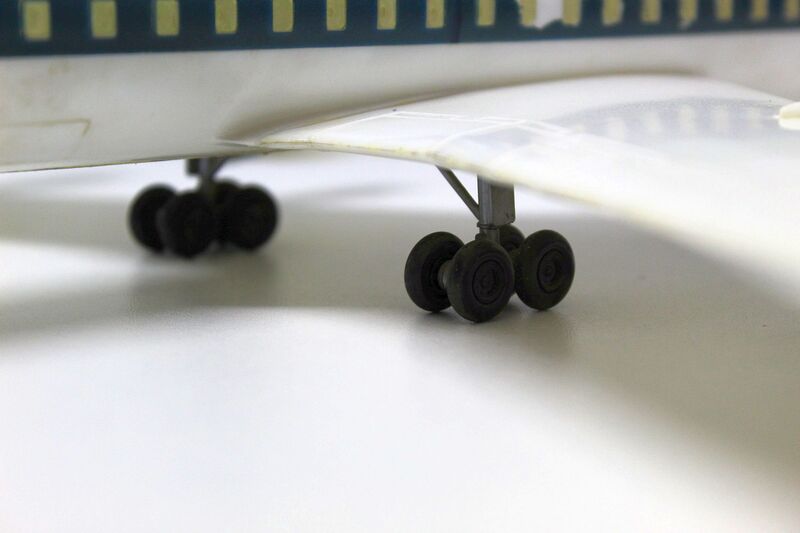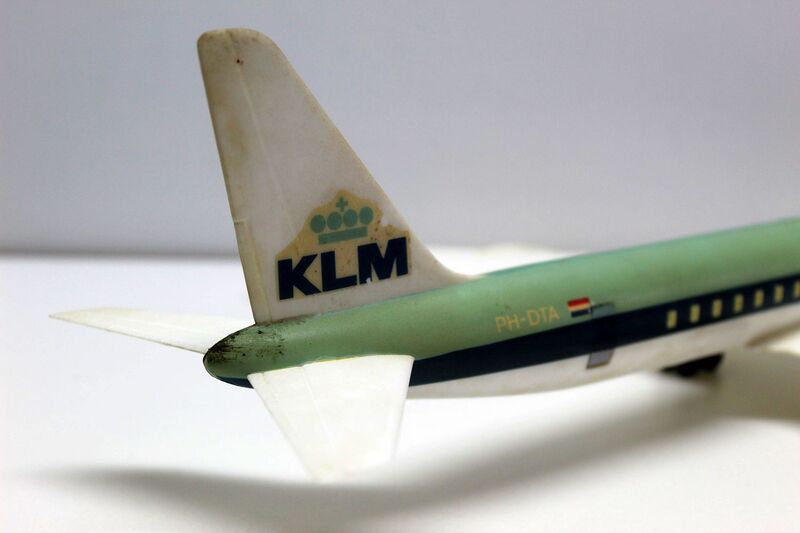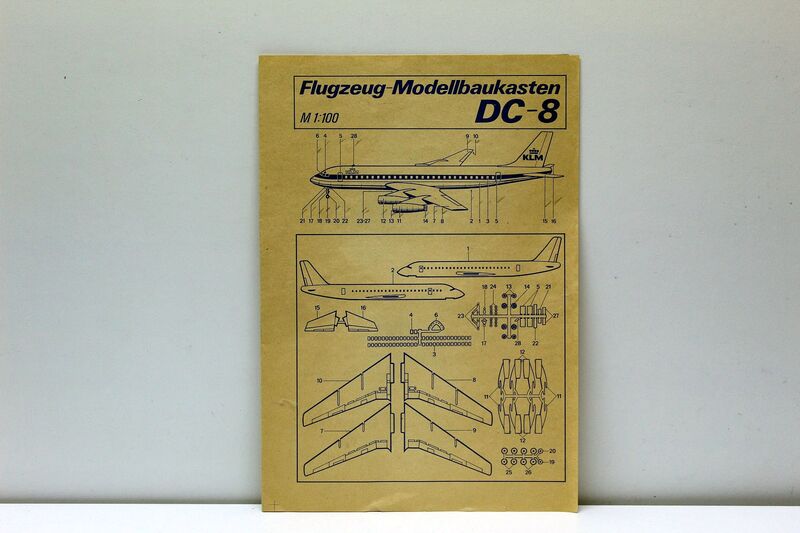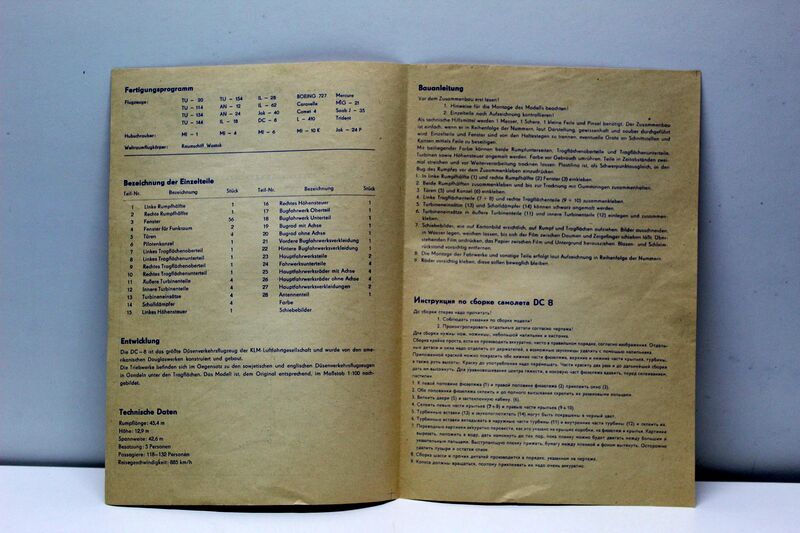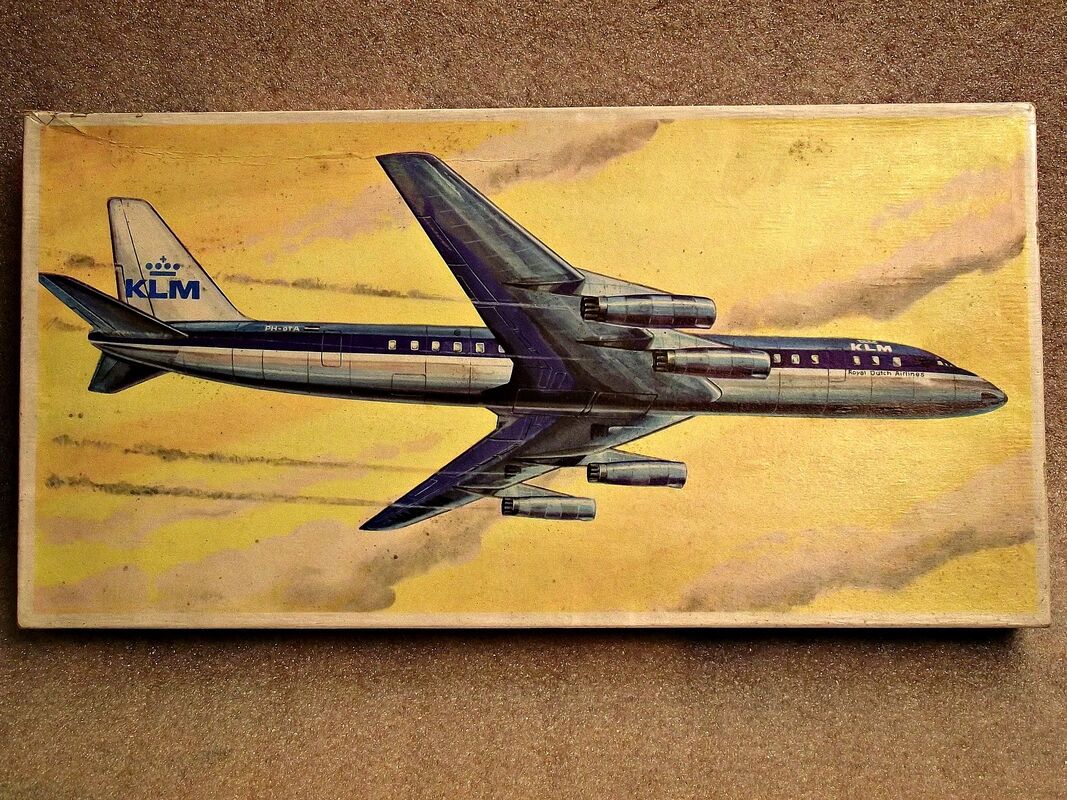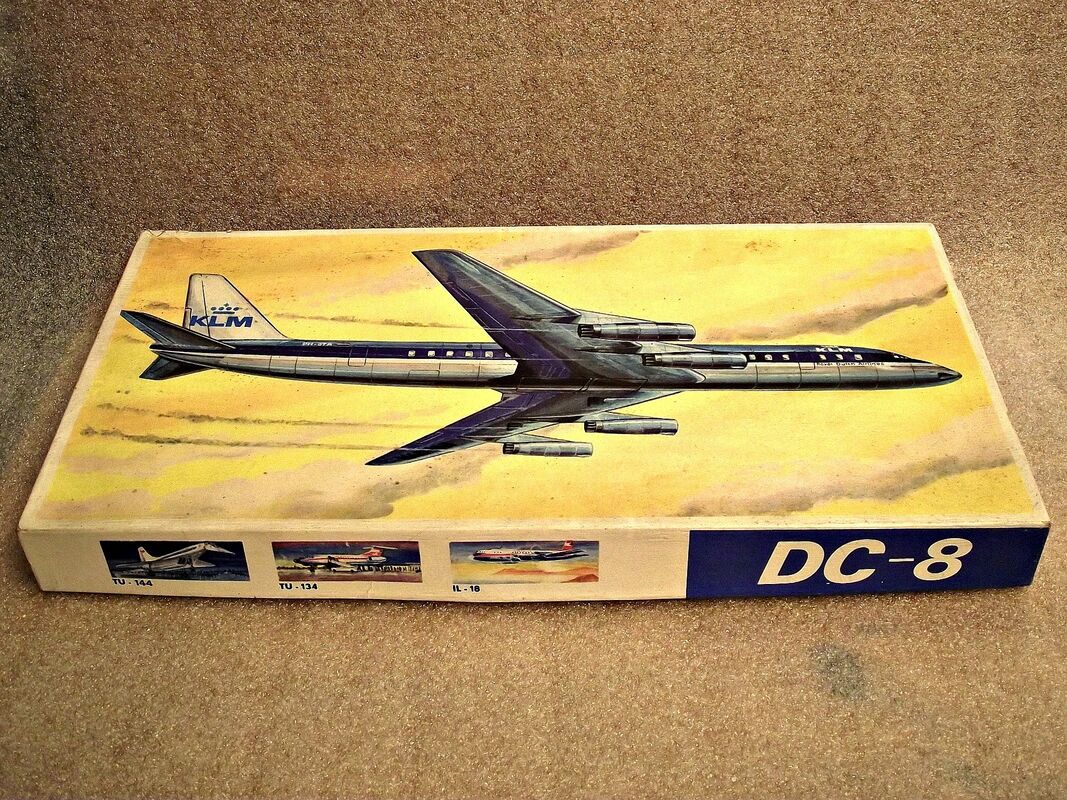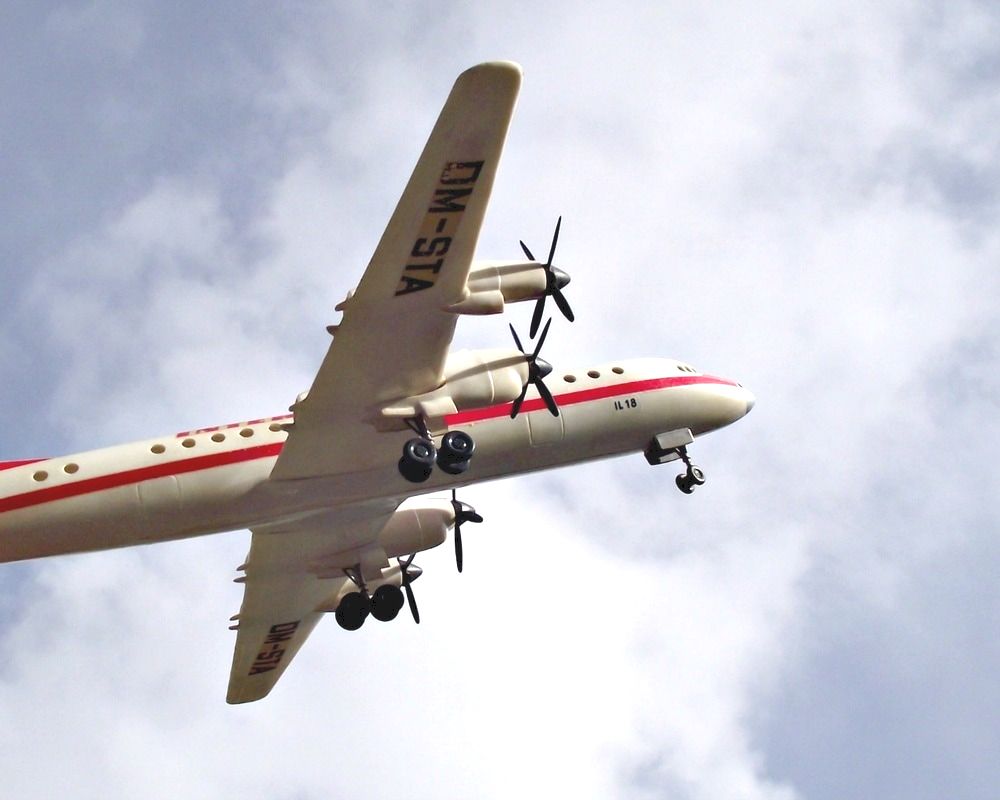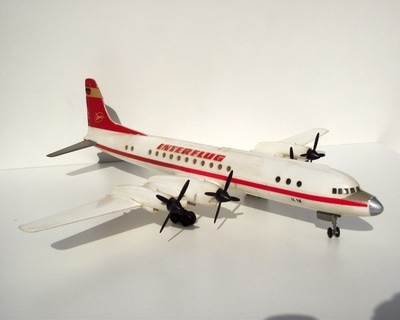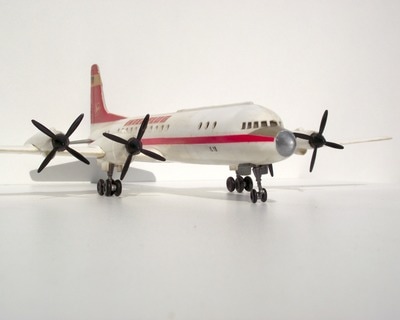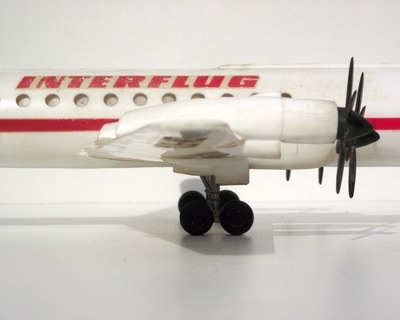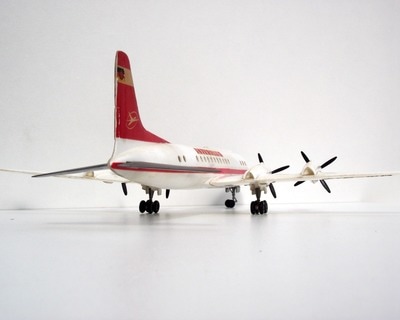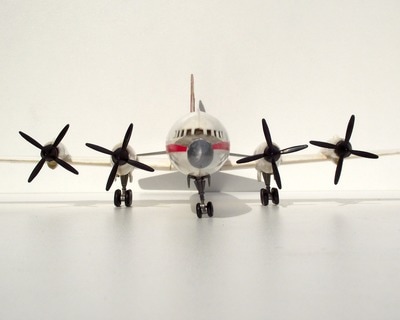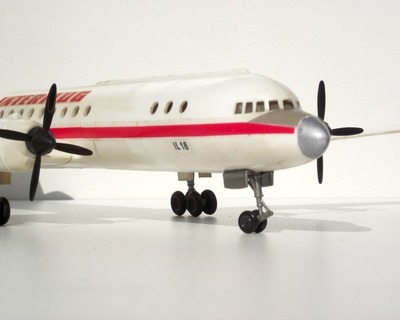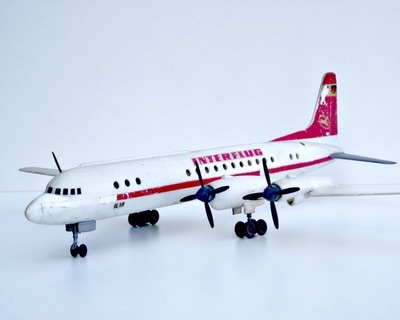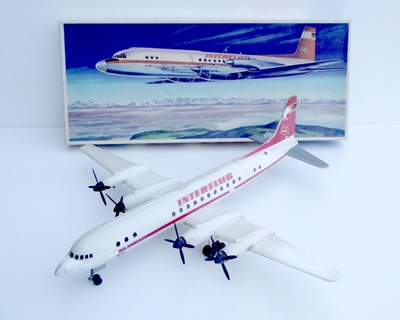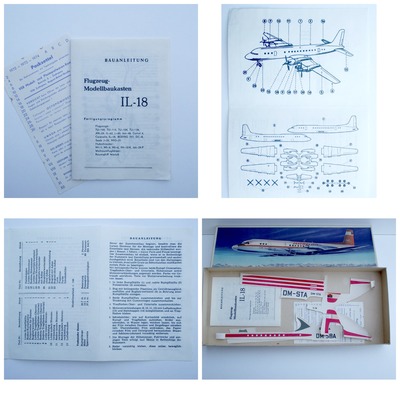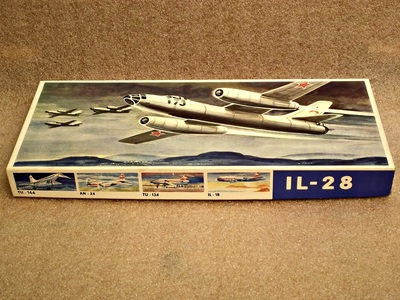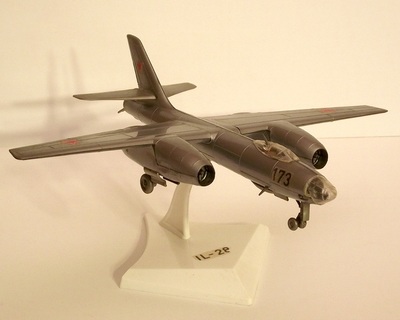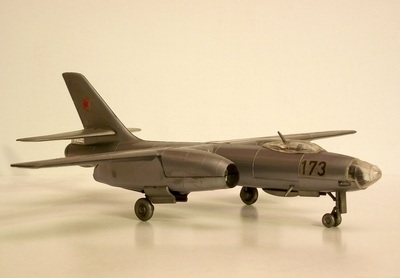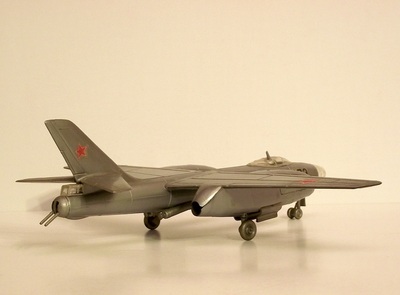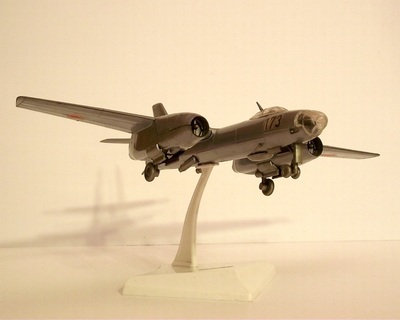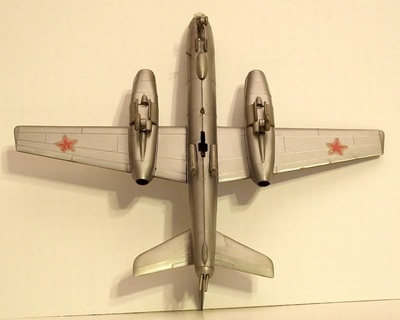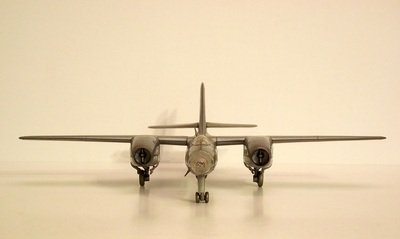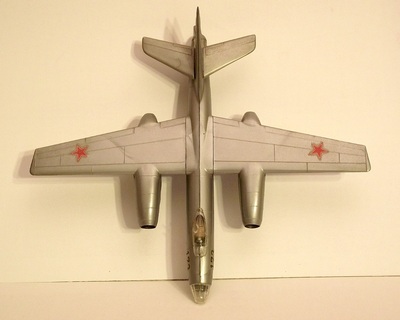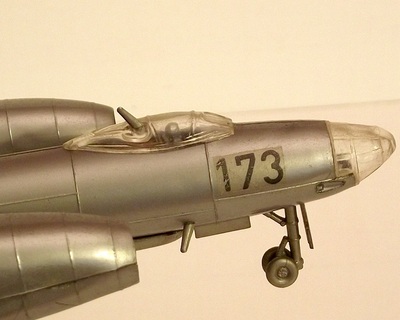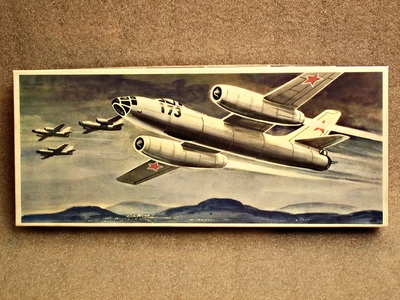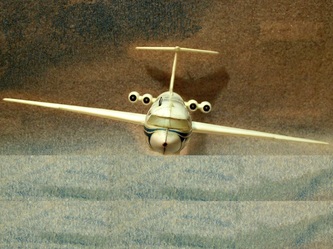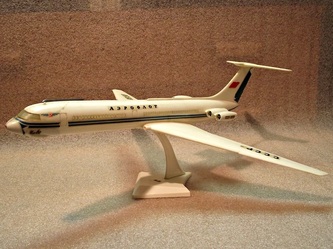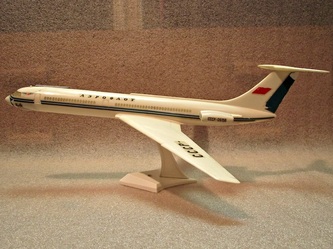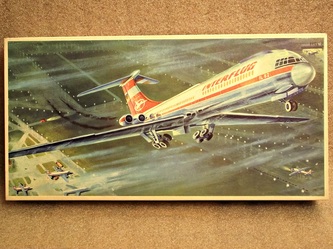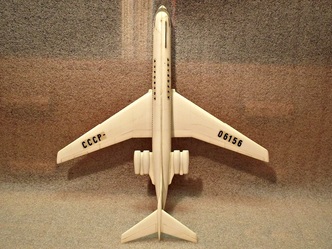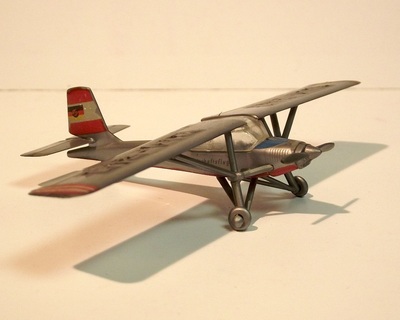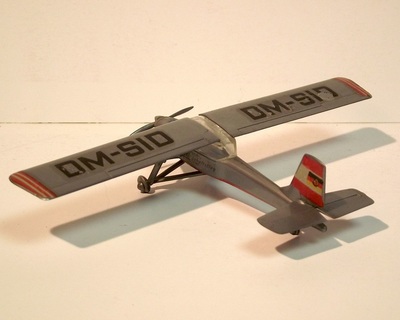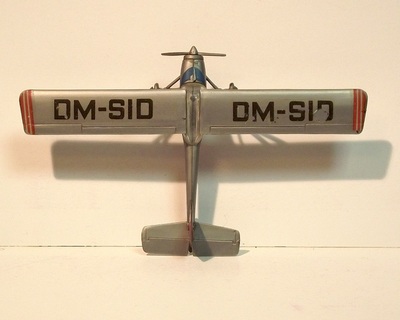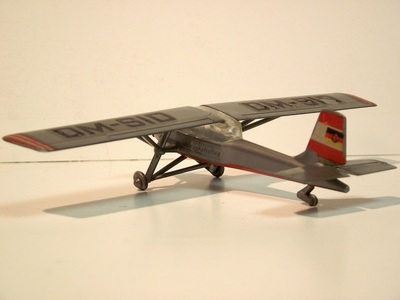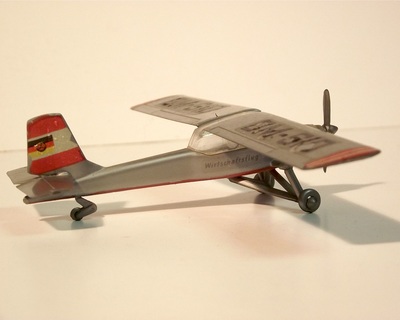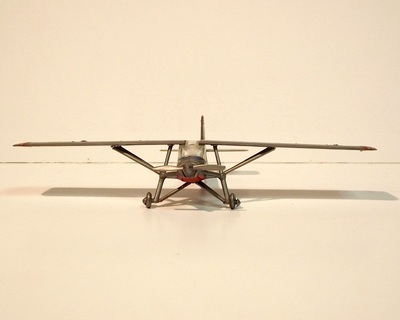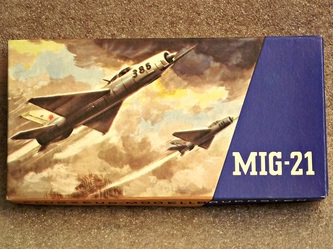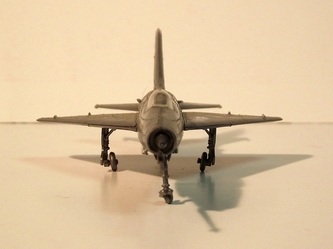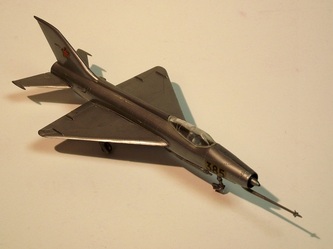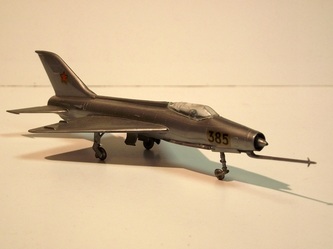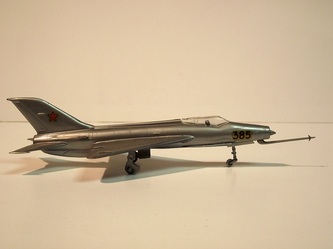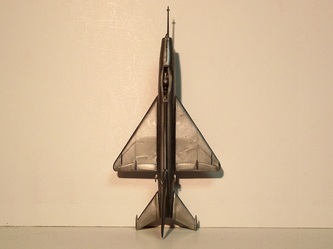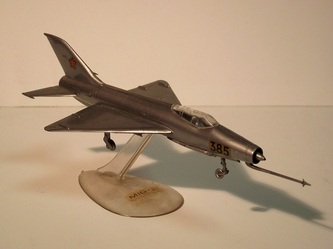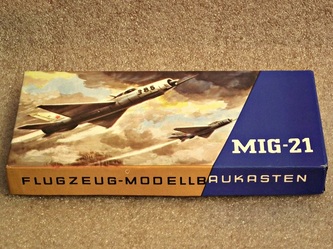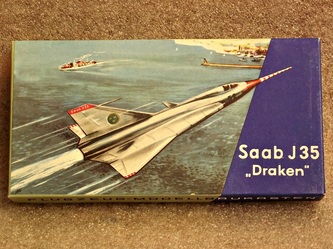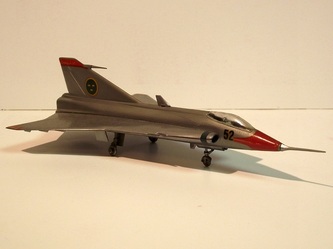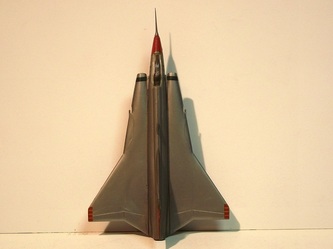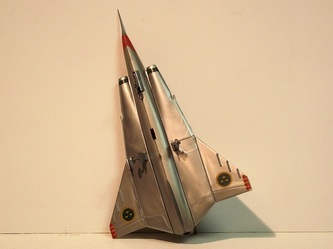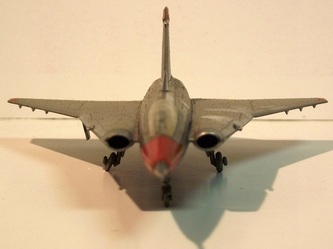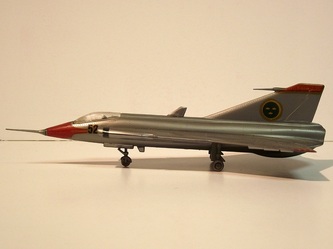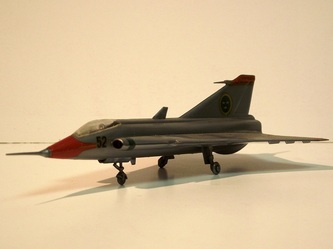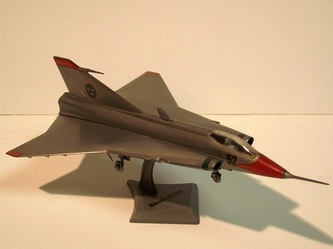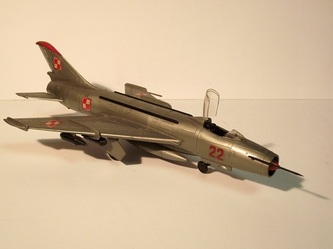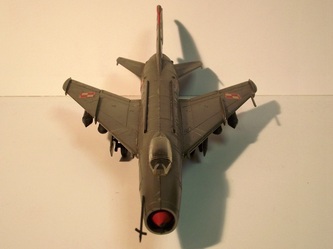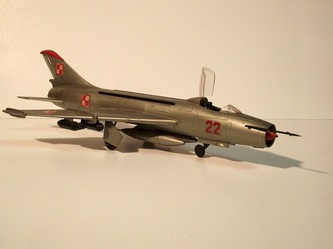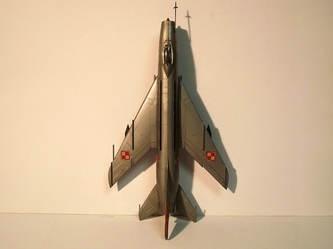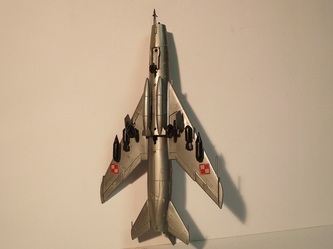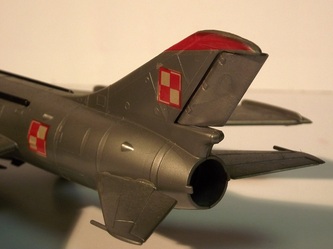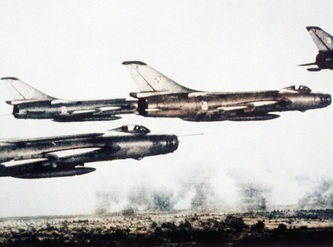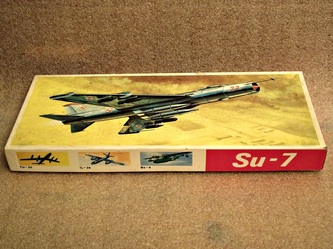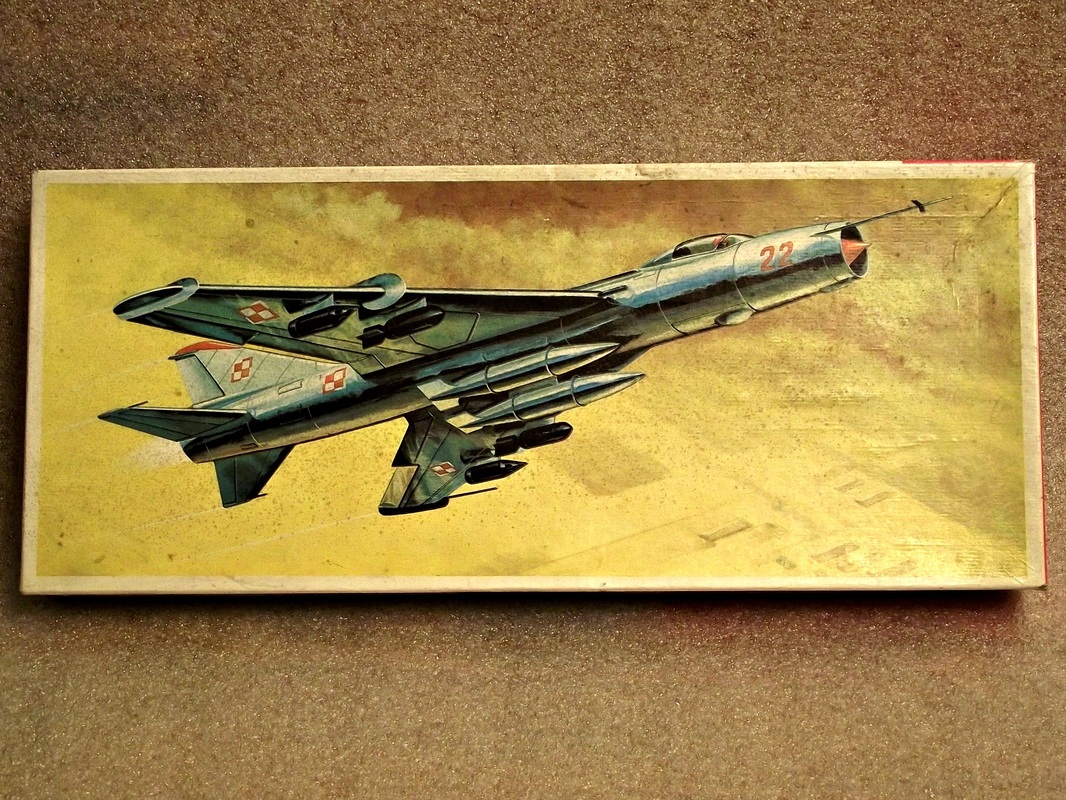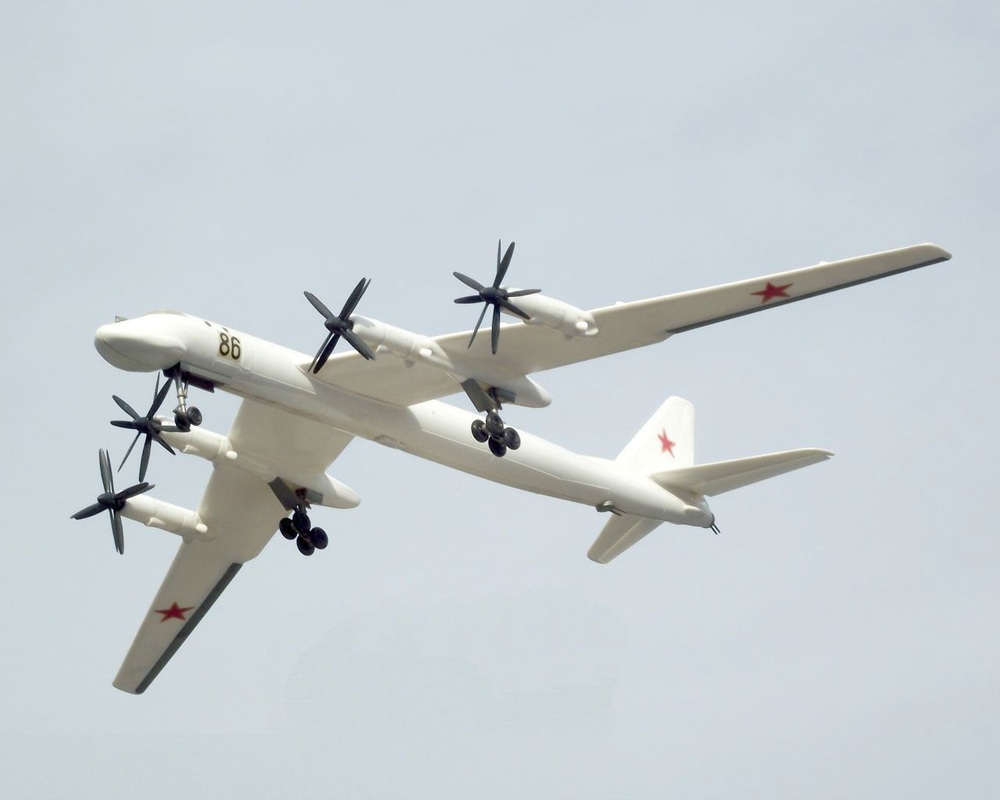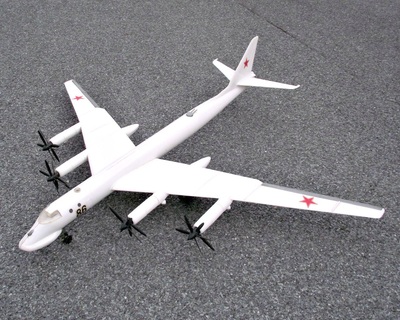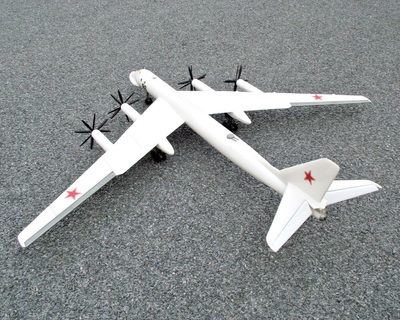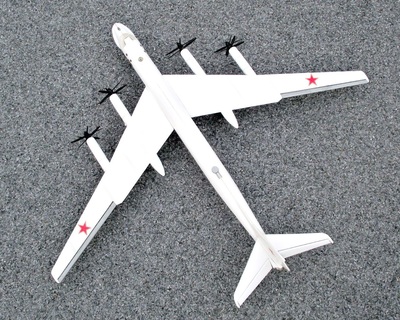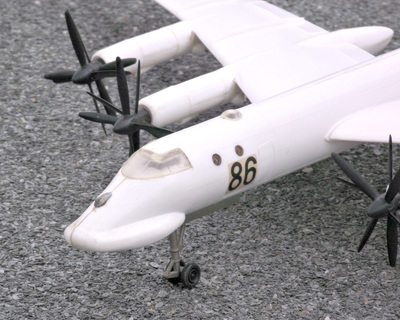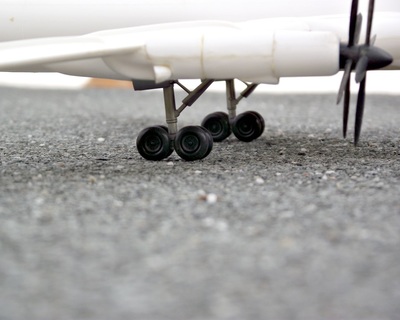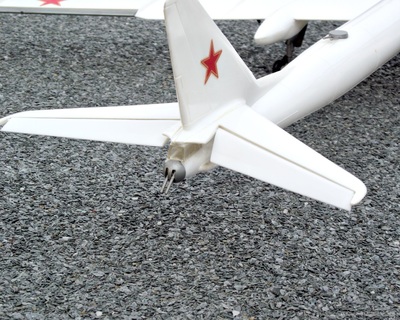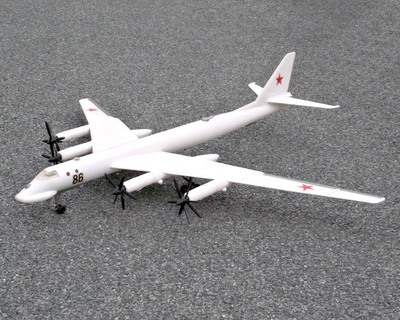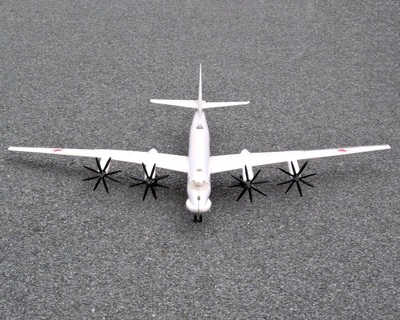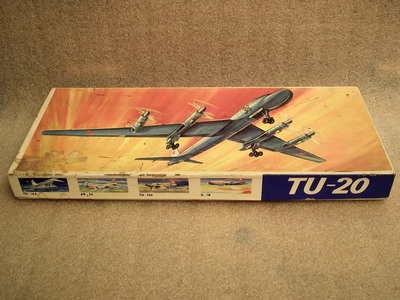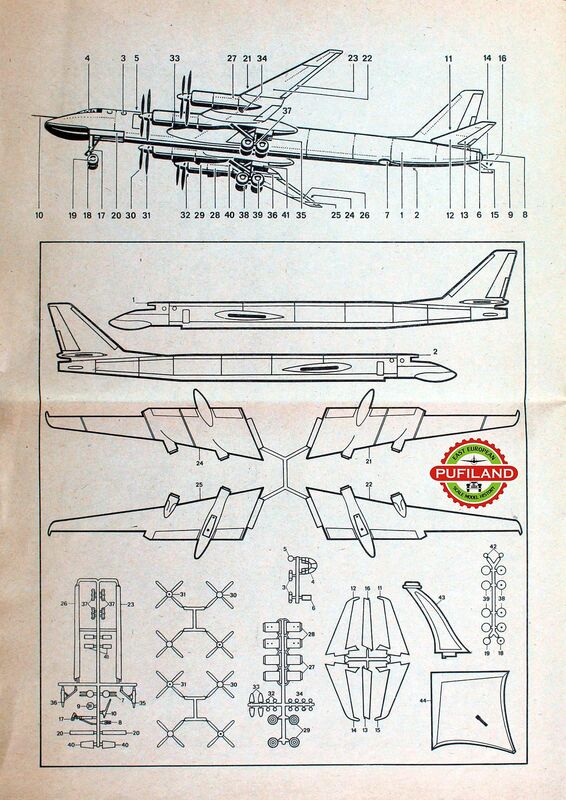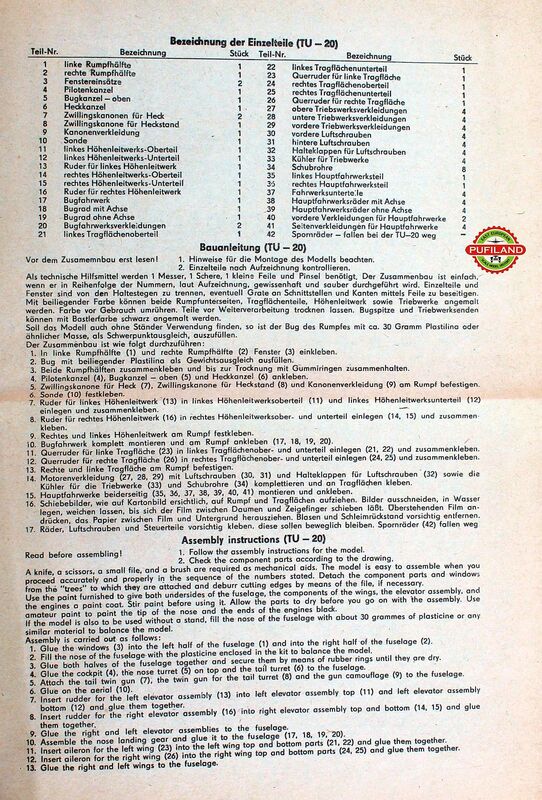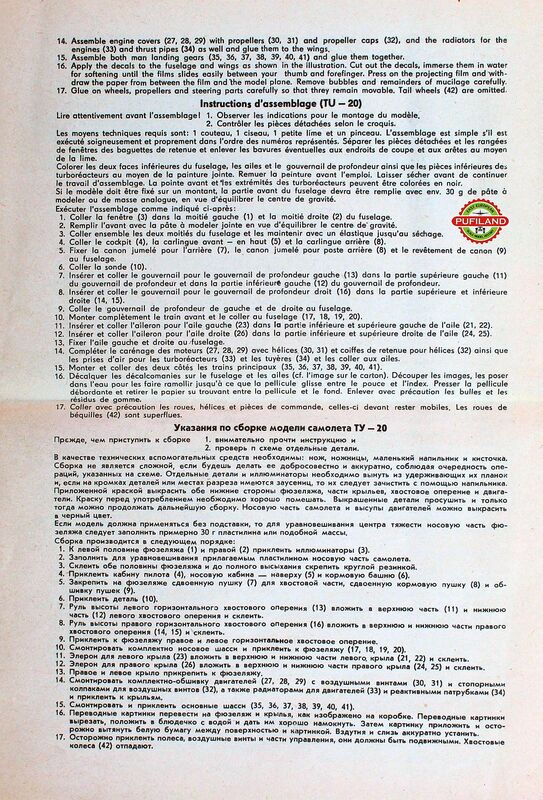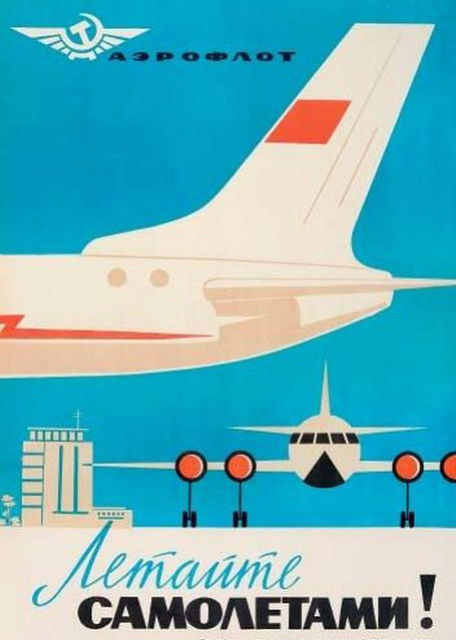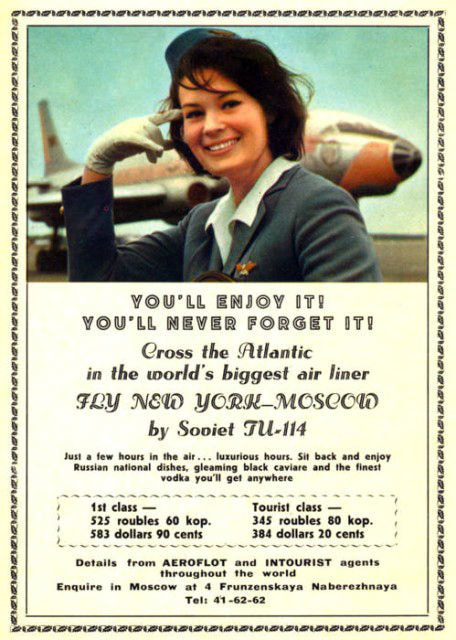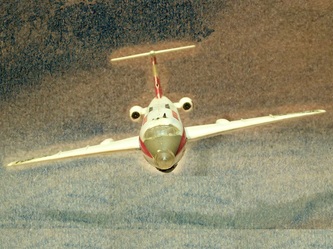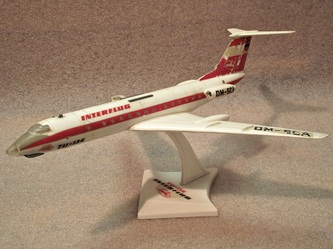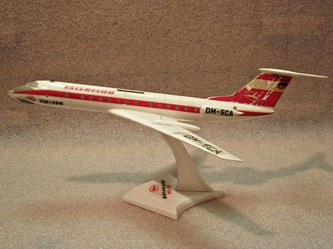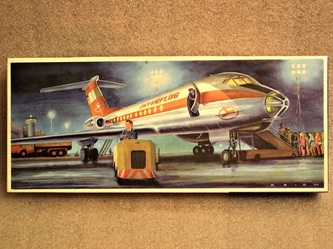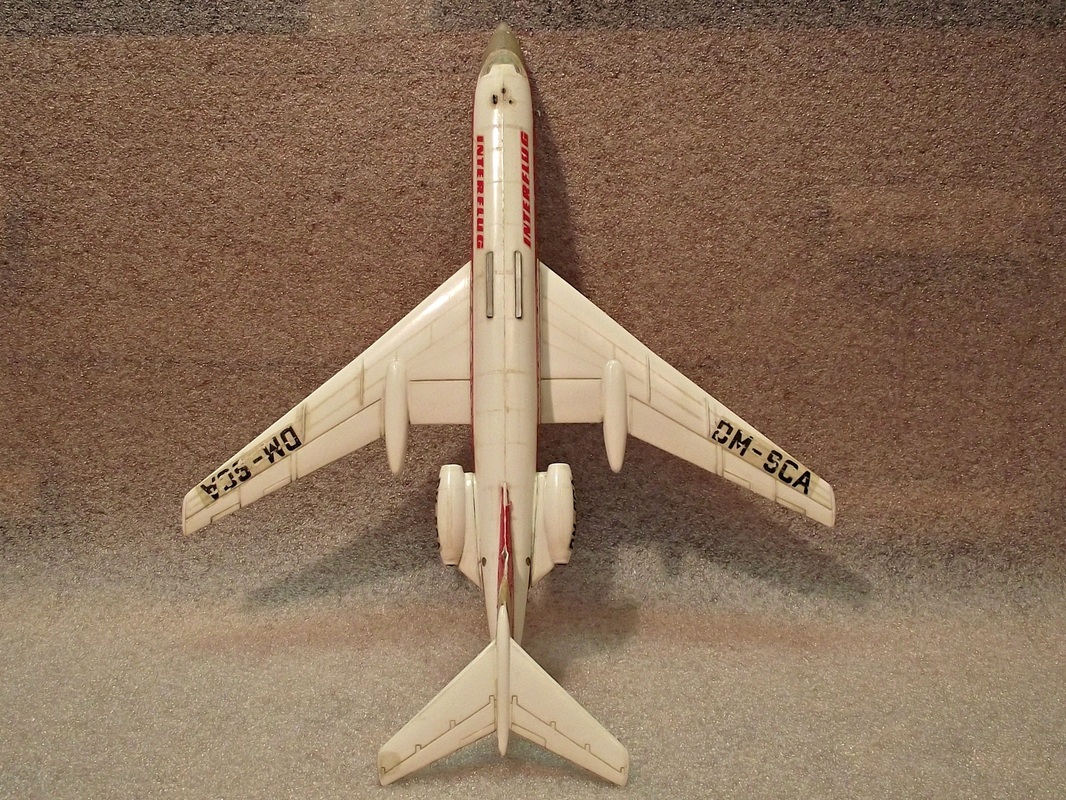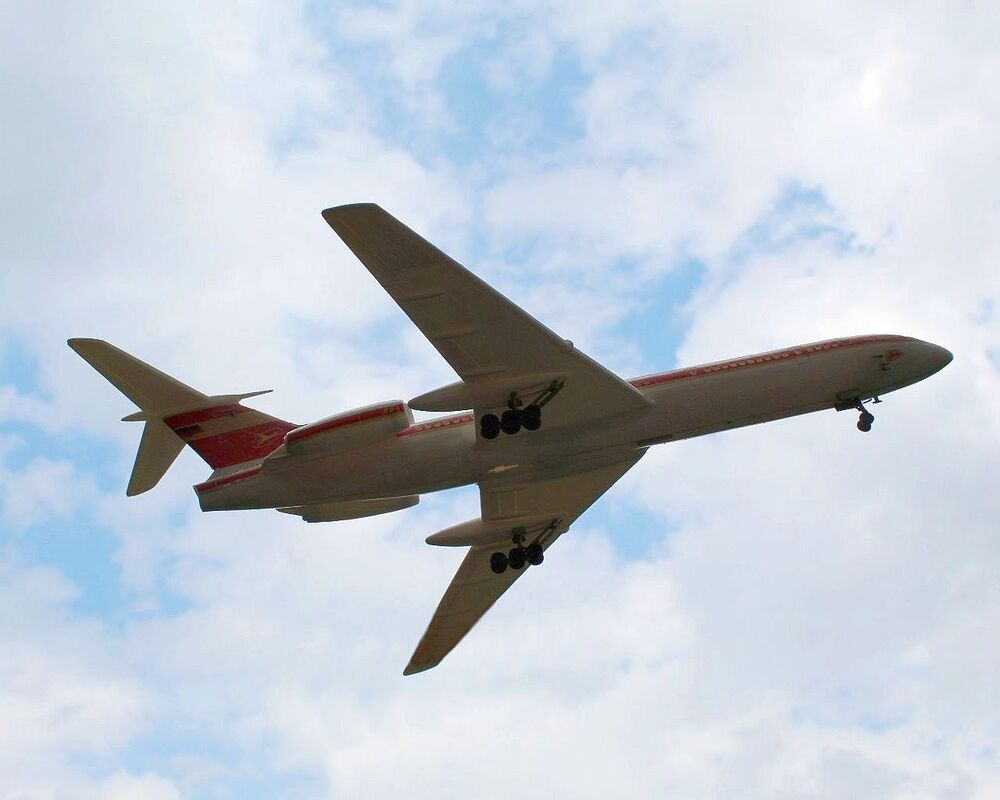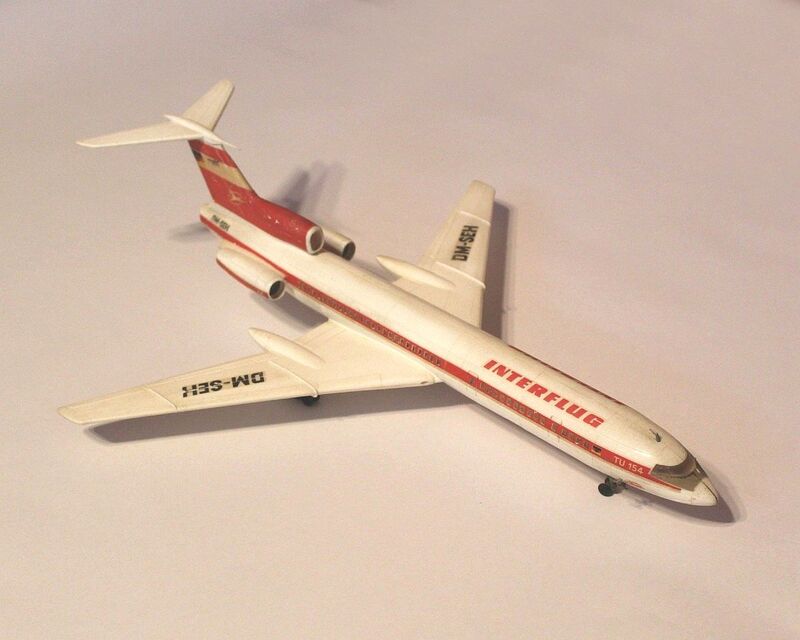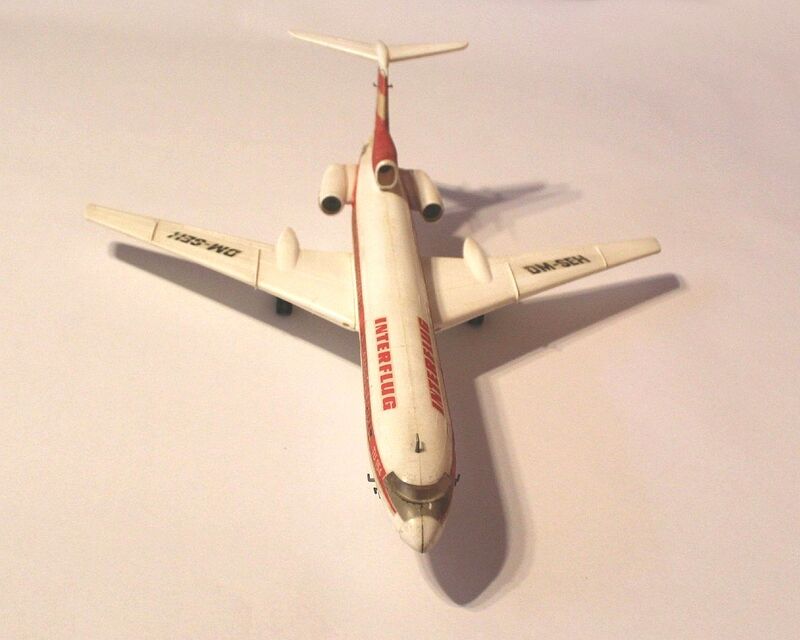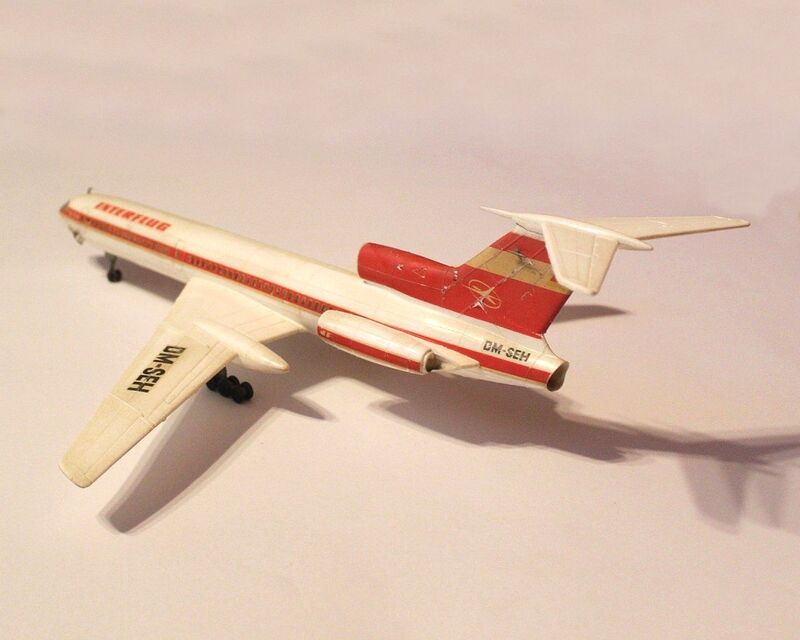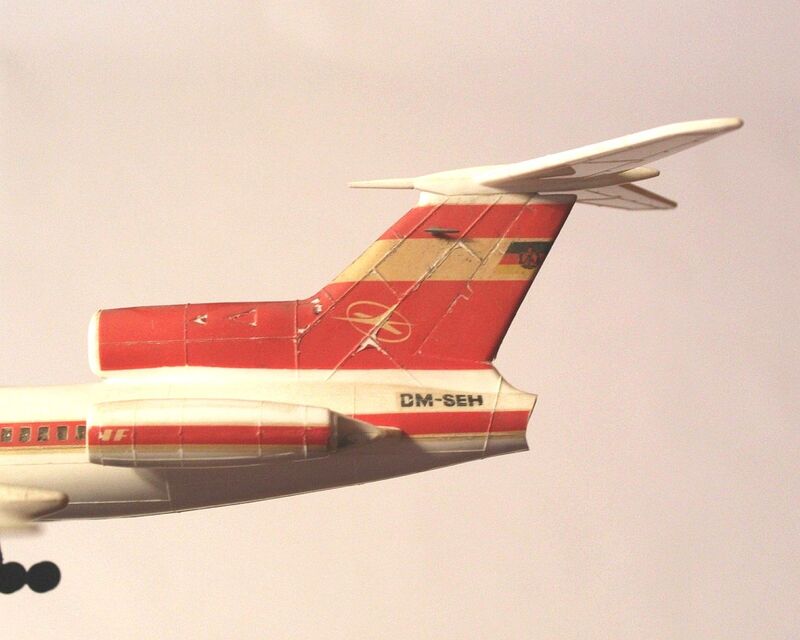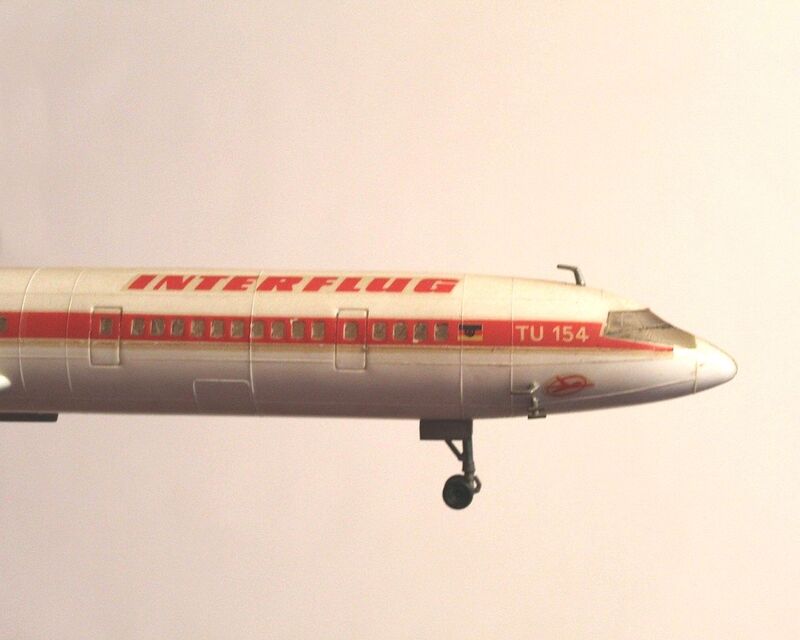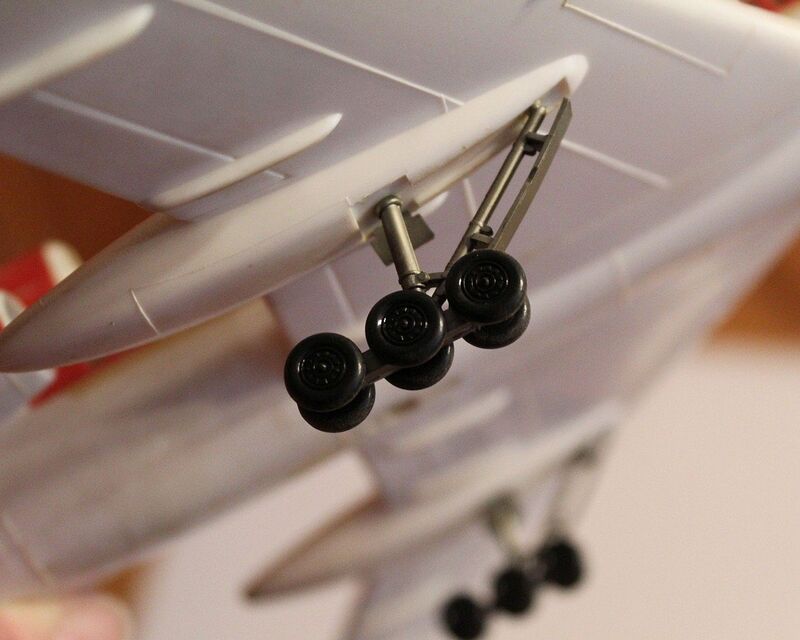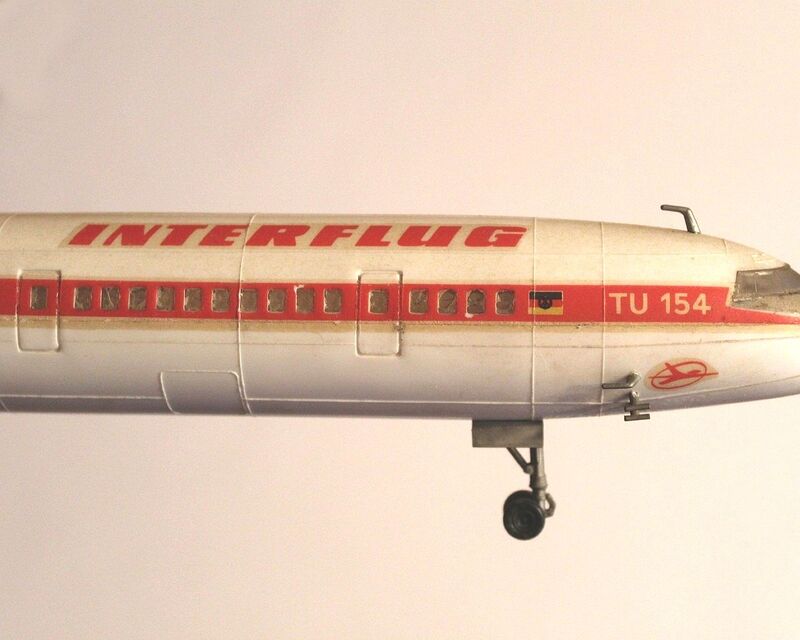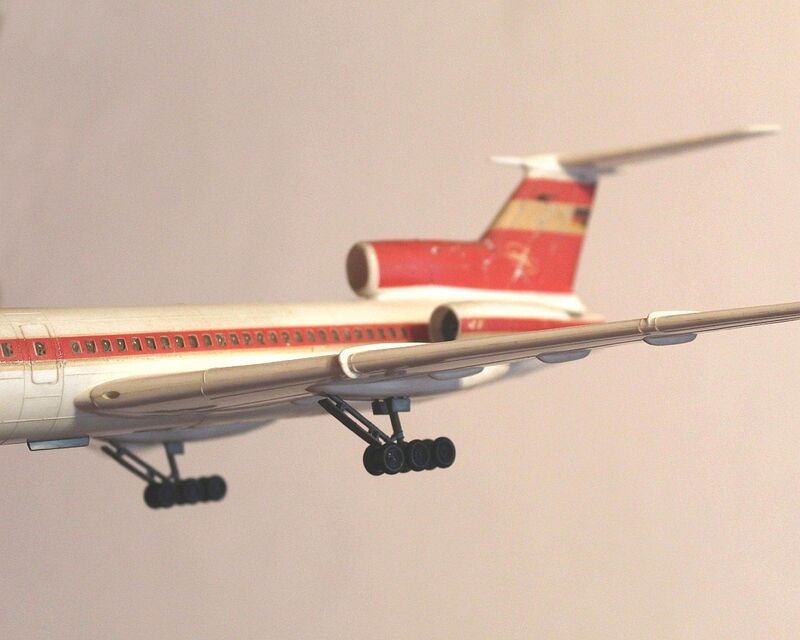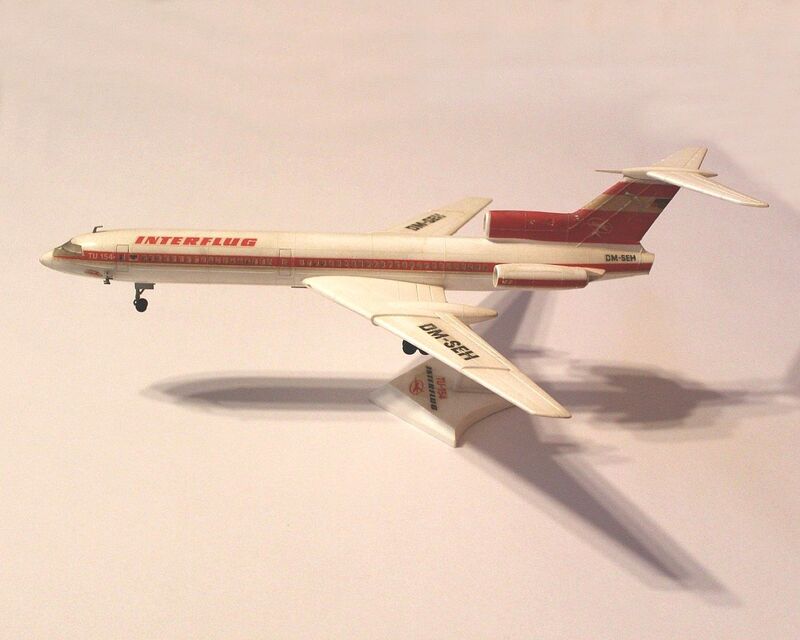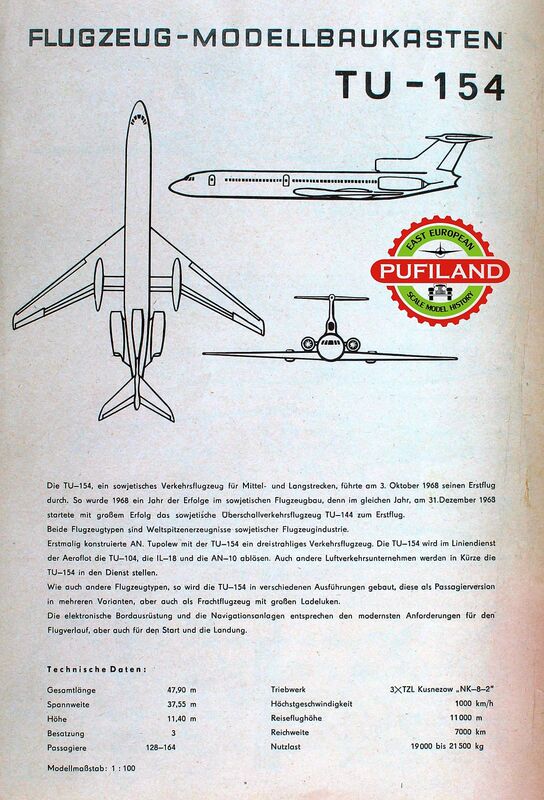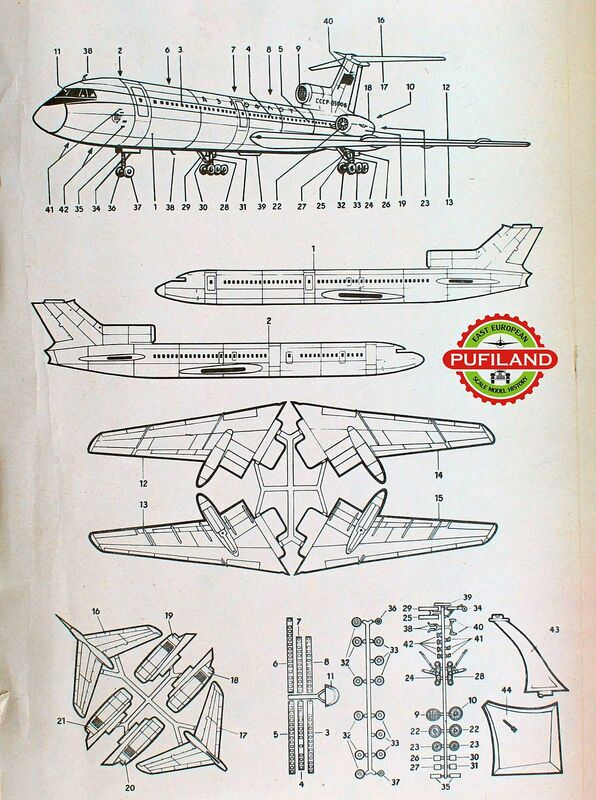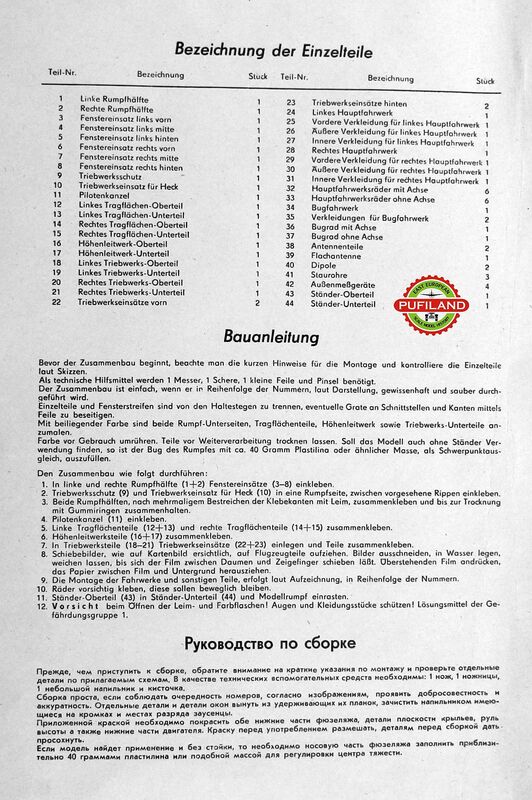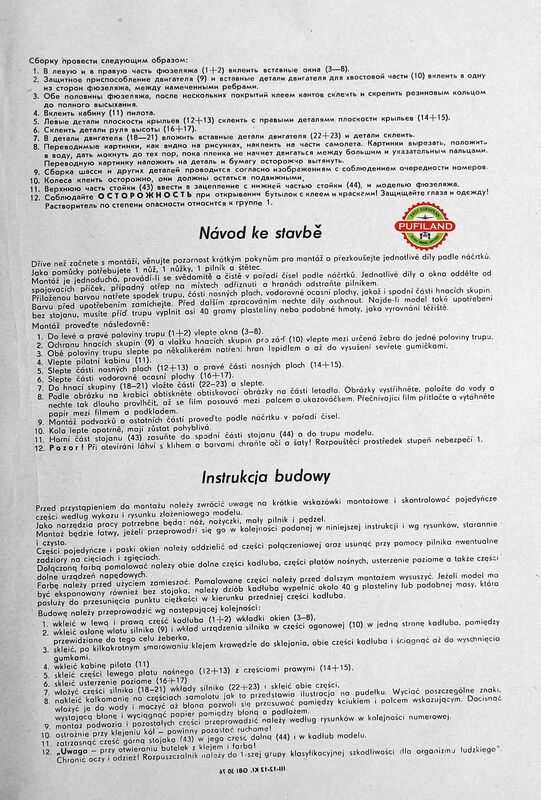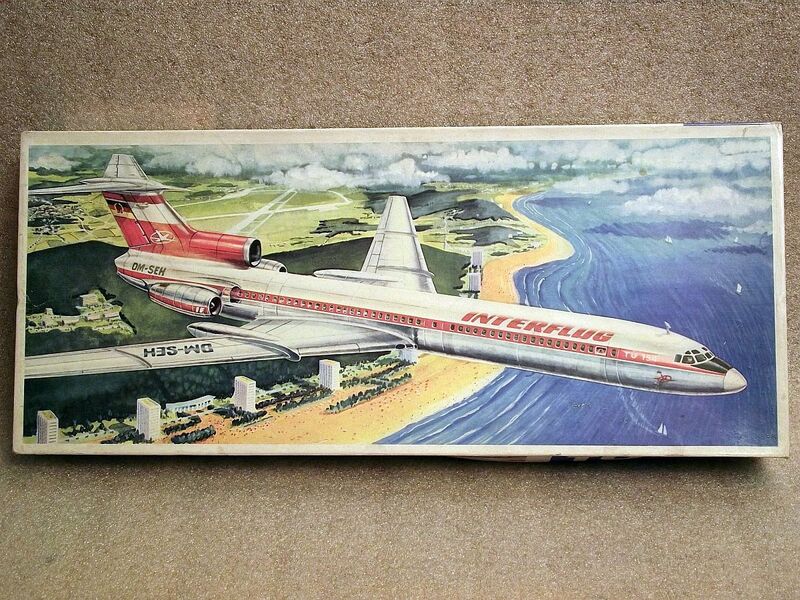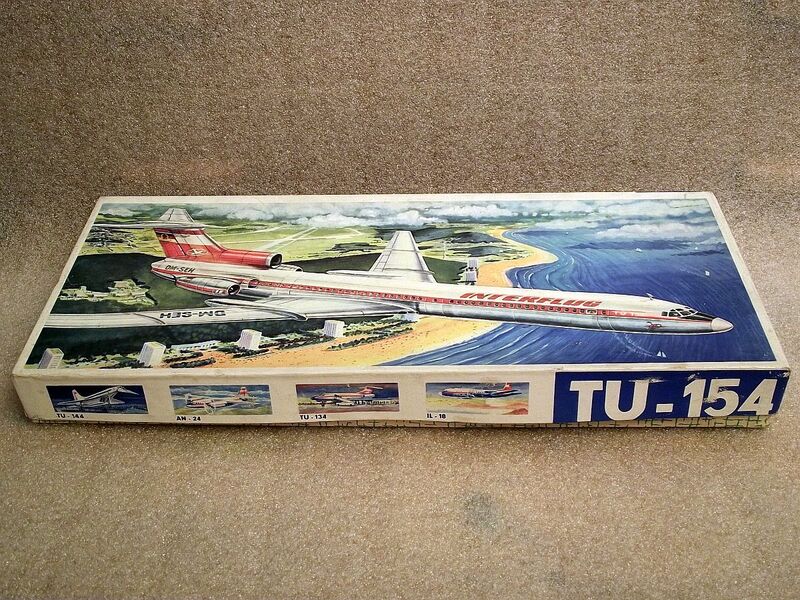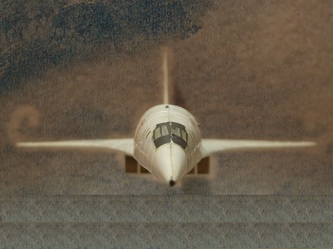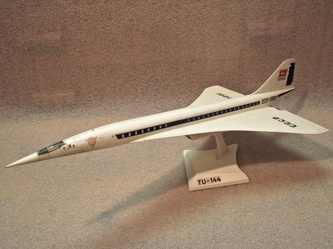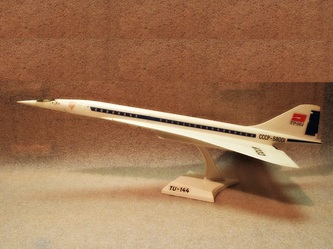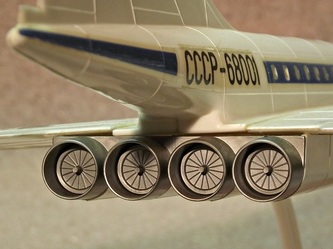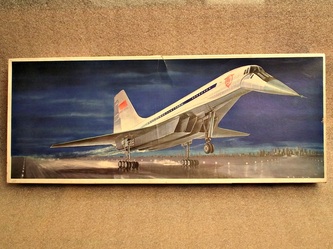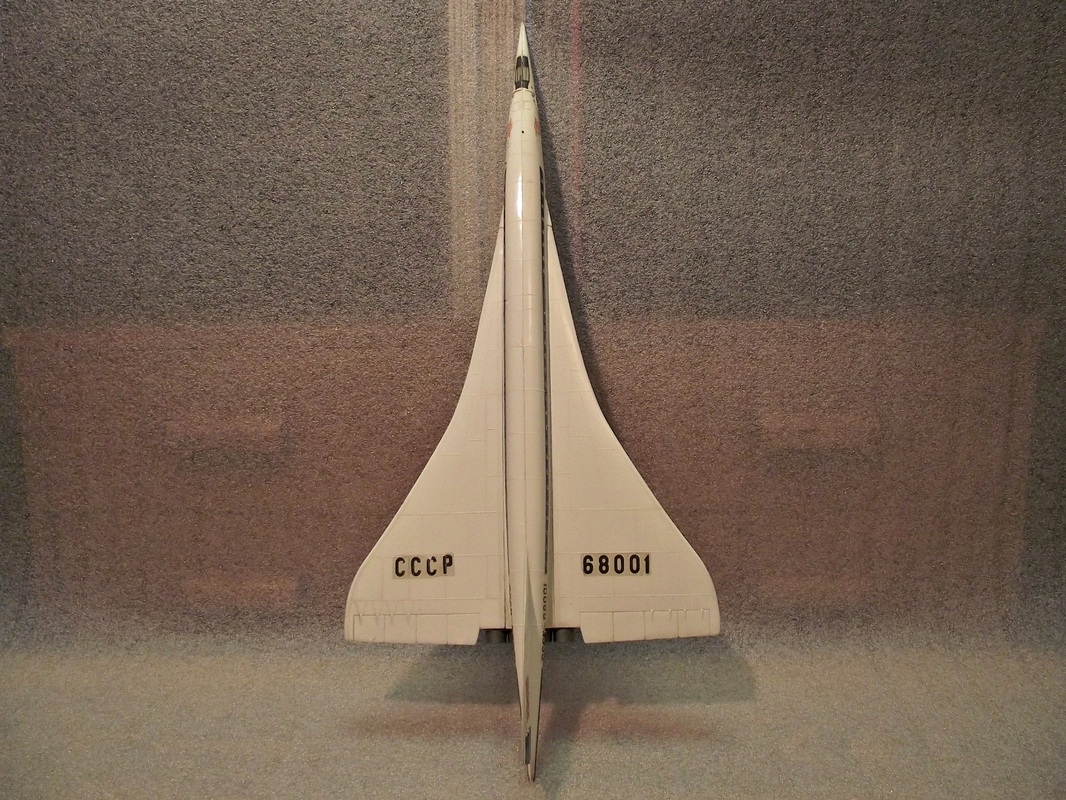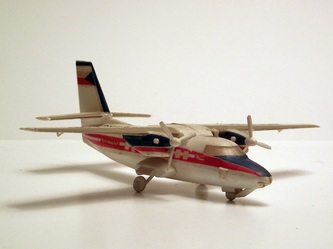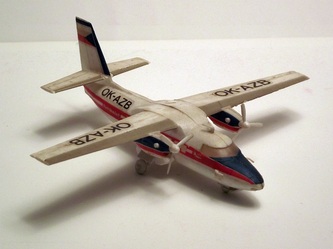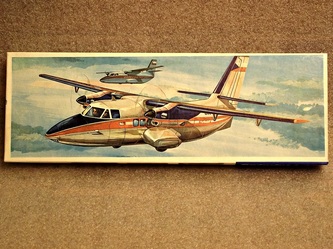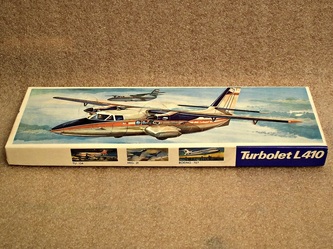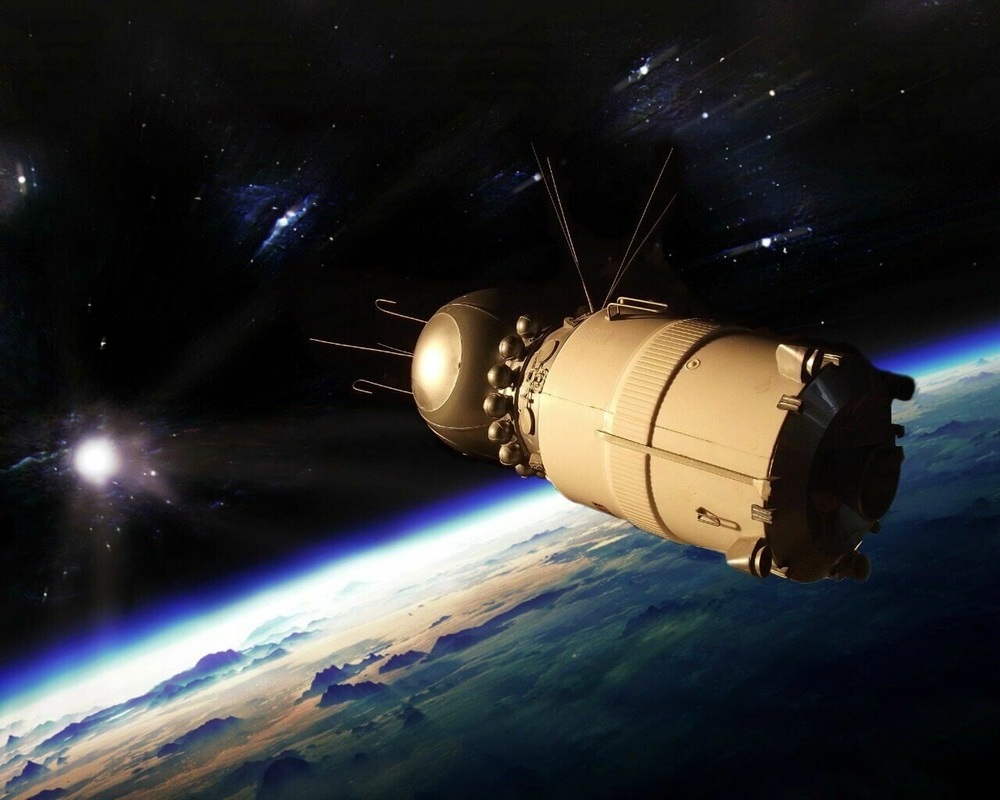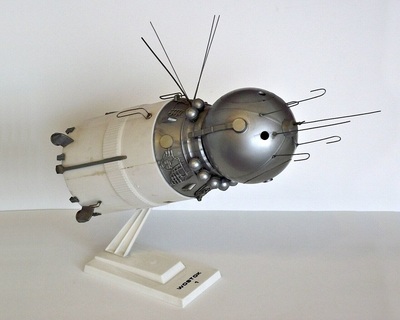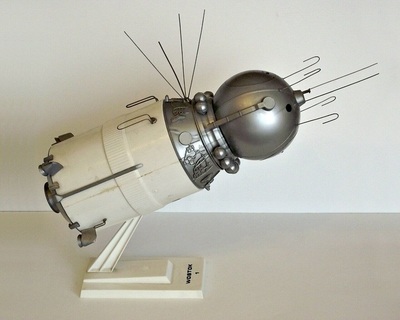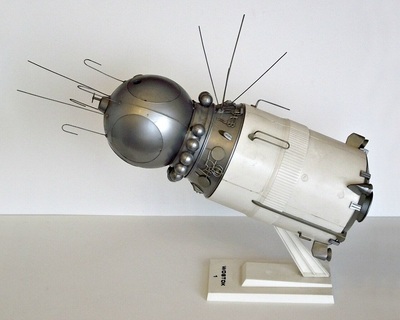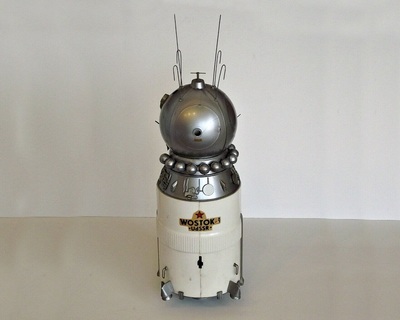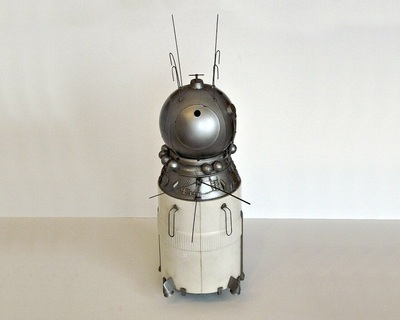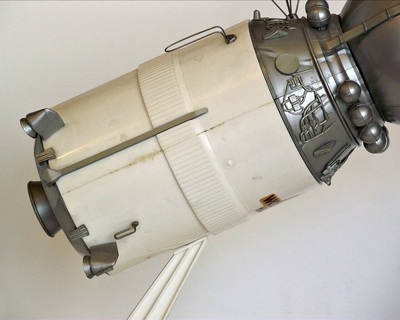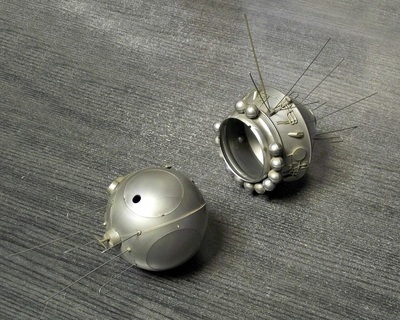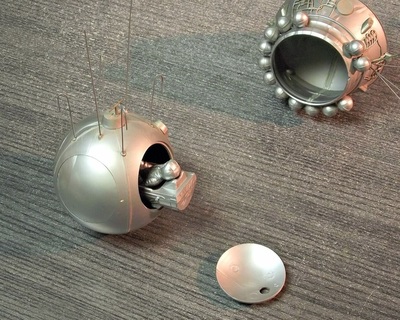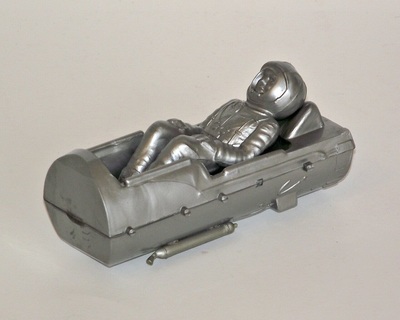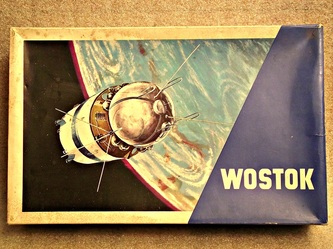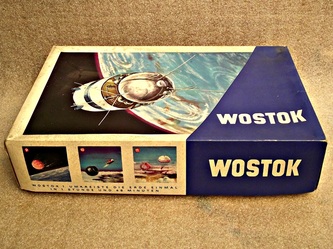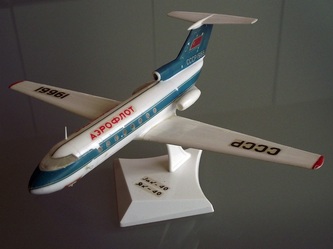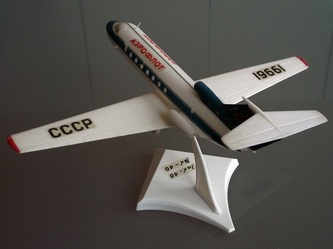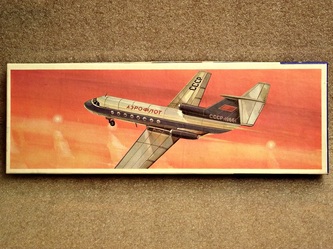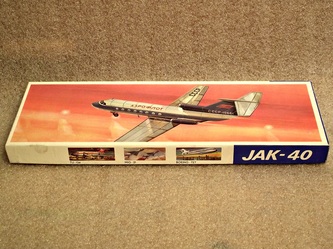|
The name VEB Plasticart should be read something like "Company Plasticart". To be more accurate VEB Plasticart means "Volkseigener Betrieb Plasticart" where VEB was a communist era designation meaning "People (read State) owned enterprise". The company was privatized in 1993 and they no longer build plastic scale model kits. In 2012 the German company Reifra resumed production of some of the former Plasticart model kits.
VEB Plasticart - complete model list
|
Aero 45 1:50
AN-2 1:75 AN-12 1:100 AN-14 1:72 AN-24 1:100 Baade 152 1:100 Beriev-6 1:72 Boeing-727-100 1:100 Caravelle 1:100 Comet-4 1:100 |
DC-8 1:100
IL-4 1:100 IL-14 1:87 IL-18 1:100 IL-28 1:100 IL-62 1:100 Ju-23/24 1:72 Yak-24P 1:100 Yak-40 1:100 L-60 1:100 |
Let-410 1:100
Mercure 1:100 Mi-1 1:100 Mi-4 1:100 Mi-6 1:87 Mi-10K 1:100 MiG-15 1:50 MiG-21 1:100 Saab J35 1:100 Su-7 1:100 |
Trident 1:100
TU-2 1:100 TU-20 1:100 aka TU95 TU-104 1:100 TU-114 1:100 TU-134 1:100 TU-144 1:100 TU-154 1:100 Wostok 1 1:25 Energija/Buran 1:288 |
Aero 45
In reality:
The Aero 45 was a twin piston-engined civil utility aircraft produced in Czechoslovakia after World War II. It proved a great success, with many of the 590 produced exported. The development began 1946 and was accomplished by the technical designers Jiři Bouzek, Ondřej Němec and František Vik. Ae-45 prototypes were widely advertised abroad. In August 1949 Jan Anderle won Norton Griffiths Race in Great Britain (Ae-45 registration OK-DCL). As a result, apart from Eastern Bloc countries, the plane was also bought by Italy and Switzerland. Hungary was a major customer, where the aircraft was known as the "Kócsag" (Hungarian for "Egret"). (source Wikipedia)
The Aero 45 was a twin piston-engined civil utility aircraft produced in Czechoslovakia after World War II. It proved a great success, with many of the 590 produced exported. The development began 1946 and was accomplished by the technical designers Jiři Bouzek, Ondřej Němec and František Vik. Ae-45 prototypes were widely advertised abroad. In August 1949 Jan Anderle won Norton Griffiths Race in Great Britain (Ae-45 registration OK-DCL). As a result, apart from Eastern Bloc countries, the plane was also bought by Italy and Switzerland. Hungary was a major customer, where the aircraft was known as the "Kócsag" (Hungarian for "Egret"). (source Wikipedia)
The model:
The scale model was made in the late 1970's by east German manufacturer VEB Kombinat PLASTICART Plastspielwaren at a scale 1:50. The pictured model was assembled in the early 1980's and the foto was taken in febr. 2013.
Last update - November 2017
The scale model was made in the late 1970's by east German manufacturer VEB Kombinat PLASTICART Plastspielwaren at a scale 1:50. The pictured model was assembled in the early 1980's and the foto was taken in febr. 2013.
Last update - November 2017
Antonov AN-2
In reality:
The Antonov AN-2 is a single-engine biplane utility/agricultural aircraft designed in the USSR in 1946. The AN-2 is used as a light utility transport, parachute drop aircraft, agricultural work and many other tasks suited to this large slow-flying biplane. Its slow flight and good field performance make it suited for short, unimproved fields. The Guinness Book of World Records states that the 45-year production run for the AN-2 was for a time the longest ever, for any aircraft, but it was recently exceeded by the Lockheed C-130 Hercules. China also builds the AN-2 under license as the Shijiazhuang Y-5.
The Antonov AN-2 is a single-engine biplane utility/agricultural aircraft designed in the USSR in 1946. The AN-2 is used as a light utility transport, parachute drop aircraft, agricultural work and many other tasks suited to this large slow-flying biplane. Its slow flight and good field performance make it suited for short, unimproved fields. The Guinness Book of World Records states that the 45-year production run for the AN-2 was for a time the longest ever, for any aircraft, but it was recently exceeded by the Lockheed C-130 Hercules. China also builds the AN-2 under license as the Shijiazhuang Y-5.
The An-2 has no stall speed quoted in the operating handbook. Pilots of the AN-2 say one can fly the aircraft in full control at 30 mph. This slow stall speed makes it possible for the aircraft to fly backwards (if the aircraft is pointed into a headwind of, say, 35 mph (56 km/h), it will travel backwards at 5 mph (8.0 km/h) whilst under full control. (source Wikipedia)
The model:
This plastic airplane model kit was made between 1962-1989 by east German manufacturer VEB Kombinat PLASTICART Plastspielwaren. It is a 1:75 scale model. The decals on this aircraft are for a former east German civilian airplane.
The model:
This plastic airplane model kit was made between 1962-1989 by east German manufacturer VEB Kombinat PLASTICART Plastspielwaren. It is a 1:75 scale model. The decals on this aircraft are for a former east German civilian airplane.
Antonov AN-12
The Antonov AN-12 was a four-engined military/civilian aircraft designed in the Soviet Union. The first flight took place in December 1957 and the aircraft remained in production until 1973. The presented injection molded kit (1/100 scale) was manufactured on July 20th 1976 (see markings on the "Packzettel") by VEB Plasticart. Molded in white, silver, black and clear including full landing gear and display stand.
The model was assembled somewhere between 1976-1978 as a military aircraft. The kit included decals for both the military version and civilian version. Due to age and storage some repair was needed. I decided to use the remaining civilian version decals from 1976 which were applied to the new/old model in 2017 replacing the military decals. There is only one problem, now I have a civilian aircraft with a defensive tail gun turret. I will try to locate the original tree and see if I can find the tail piece that was included for building the civilian version. The beautiful box art is signed REICH and shows a civilian version as a support aircraft for distant explorers.
Published May 27th 2017
The model was assembled somewhere between 1976-1978 as a military aircraft. The kit included decals for both the military version and civilian version. Due to age and storage some repair was needed. I decided to use the remaining civilian version decals from 1976 which were applied to the new/old model in 2017 replacing the military decals. There is only one problem, now I have a civilian aircraft with a defensive tail gun turret. I will try to locate the original tree and see if I can find the tail piece that was included for building the civilian version. The beautiful box art is signed REICH and shows a civilian version as a support aircraft for distant explorers.
Published May 27th 2017
BOEING 727
In reality:
The BOEING 727 is a mid-size three-engine jet aircraft introduced in 1964.
The model:
This plastic airplane model kit was the first edition and it was made between 1968-1973 by east German manufacturer VEB Kombinat PLASTICART Plastspielwaren. It is a 1:100 scale model. It came with PAN AMERICAN decals for a true to original look.
The BOEING 727 is a mid-size three-engine jet aircraft introduced in 1964.
The model:
This plastic airplane model kit was the first edition and it was made between 1968-1973 by east German manufacturer VEB Kombinat PLASTICART Plastspielwaren. It is a 1:100 scale model. It came with PAN AMERICAN decals for a true to original look.
COMET 4
In reality:
The de Havilland DH 106 Comet was the world's first production commercial jet airliner. The Comet first flew in 1949 and was a landmark in aeronautical design. The Comet 4 was considered the definitive series, having a longer range, higher cruising speed and higher maximum takeoff weight.
The model:
This model kit is the second edition and it was made between 1973-1986 by east German manufacturer VEB Kombinat PLASTICART Plastspielwaren at a 1:100 scale. True to the original it uses B O A C (British Overseas Airways Corporation) decals as used during the 1950's and 1960's.
The de Havilland DH 106 Comet was the world's first production commercial jet airliner. The Comet first flew in 1949 and was a landmark in aeronautical design. The Comet 4 was considered the definitive series, having a longer range, higher cruising speed and higher maximum takeoff weight.
The model:
This model kit is the second edition and it was made between 1973-1986 by east German manufacturer VEB Kombinat PLASTICART Plastspielwaren at a 1:100 scale. True to the original it uses B O A C (British Overseas Airways Corporation) decals as used during the 1950's and 1960's.
DC-8
The DC-8 (McDonnell Douglas DC-8) is an American four-engine mid to long-range jet airliner built from 1958 to 1972. It first entered service with Delta Air Lines and United Airlines quickly followed by KLM and others. This DC-8 scale model was made by VEB Plasticart at a scale of 1:100. Plastic components were moulded in white, silver/grey, black and transparent pieces. It was assembled somewhere in mid to late 70s. The package contained one tube with glue, one with silver paint and assembly instructions in German. Unfortunately this model is in a pretty bad shape due to storage conditions but I hope that I can improve it sometime in the near future.
In 2019 KLM (Royal Dutch Airlines) became the world's first airline still operating under its original name to mark its 100th anniversary.
In 2019 KLM (Royal Dutch Airlines) became the world's first airline still operating under its original name to mark its 100th anniversary.
IL-18 (Ilyushin 18)
The Ilyusin IL-18 large turboprop airilner first flew in 1957 and it was built until 1985. It is one of the best known and durable Soviet aircraft of it's era. In 1958 the aircraft was awarded the Brussels World Fair Grand Prix. The sucessor of this aircraft is the IL-62. The IL-18 plastic scale model presented here was made by VEB Plasticart and acording to the "Packzettel" (inlay) it was made on 12th of June 1973. The package contained white, black and silver plastic components, decals and glue. On a correctly assembled model the wheels are turning, the front wheel can be rotated and the propellers are rotating. In the last 20 years the model was stored in the attic gathering dust so it became very dirty and needed some cleaning. After some dry brush and wet cleaning some of the decals came off (see the last pictures) so in February 2017 when the pictures were taken I've added a few pieces of decals that remained in excess in the box. The decals were still good to use after 40+ years. The box cover art is signed REICH, scale is 1:100.
IL-28 (Ilyushin 28) Beagle
In reality:
The Ilyushin IL-28 Beagle was a successful Soviet product of the early Cold War years. It was a Tactical Strike Medium Bomber (codenamed "Beagle" by NATO) a jet bomber aircraft introduced in 1950 (first flight 1948)
The model:
This model kit was made between 1970-1991 by east German manufacturer VEB Kombinat PLASTICART Plastspielwaren at a 1:100 scale.
The Ilyushin IL-28 Beagle was a successful Soviet product of the early Cold War years. It was a Tactical Strike Medium Bomber (codenamed "Beagle" by NATO) a jet bomber aircraft introduced in 1950 (first flight 1948)
The model:
This model kit was made between 1970-1991 by east German manufacturer VEB Kombinat PLASTICART Plastspielwaren at a 1:100 scale.
IL-62 (Ilyushin 62)
In reality:
The IL-62 (Ilyushin 62) is a Soviet long-range jet airliner conceived in 1960 by Ilyushin, one of the Soviet aircraft design bureau. As a succesor of the IL-18 and with a capacity of 200 passengers it was the largest jet airliner when it first flew in 1963. (source Wikipedia)
The IL-62 (Ilyushin 62) is a Soviet long-range jet airliner conceived in 1960 by Ilyushin, one of the Soviet aircraft design bureau. As a succesor of the IL-18 and with a capacity of 200 passengers it was the largest jet airliner when it first flew in 1963. (source Wikipedia)
|
The model:
This model kit was made between 1968-1987 by east German manufacturer VEB Kombinat PLASTICART Plastspielwaren at a 1:100 scale. Being a successful aircraft it was exported to many other countries. The plastic model came with INTERFLUG (former east German airlnes) and AEROFLOT decals. The assambled kit was decorated with AEROFLOT decals for variety as there were already other kits in the collection made with INTERFLUG decals. |
L-60
The L-60 is a 1:100 scale model made by VEB Kombinat PLASTICART Plastspielwaren between 1962 and 1988. Also known as L-60 "Brigadier" this is a very small aircraft (1 person) with a 13.96 m wingspan.
The photos from above show a model from my collection assembled in 1973 using East German markings. One interesting detail is the fact that the first series (from 1962) was available with "Lufthansa" (West German) markings. On the side of the airplane is a marking that reads "Wirtschafstflug" which would translate as economy flight, utility aircraft.
Published August 30th 2015
The photos from above show a model from my collection assembled in 1973 using East German markings. One interesting detail is the fact that the first series (from 1962) was available with "Lufthansa" (West German) markings. On the side of the airplane is a marking that reads "Wirtschafstflug" which would translate as economy flight, utility aircraft.
Published August 30th 2015
MIG-21
In reality:
The MiG-21 is a supersonic jet fighter aircraft, designed by the Mikoyan-Gurevich Design Bureau in the Soviet Union. It was popularly nicknamed "balalaika", from the aircraft's planform-view resemblance to the Russian stringed musical instrument or "ołówek" (English: pencil) by Polish pilots due to the shape of its fuselage. Some 50 countries over four continents have flown the MiG-21, and it still serves many nations a half-century after its maiden flight. It is the most-produced supersonic jet aircraft in aviation history and the most-produced combat aircraft since the Korean War, and it had the longest production run of a combat aircraft (1959 to 1985 over all variants). A total of 10,645 aircraft were built in the USSR. (source Wikipedia)
The model:
This model kit was made between 1973-1991 by east German manufacturer VEB Kombinat PLASTICART Plastspielwaren at a 1:100 scale. All the components of this model aircraft are made of silver plastic.
The decals used were a former Soviet military aircraft, see the Red Star on the wings.
The MiG-21 is a supersonic jet fighter aircraft, designed by the Mikoyan-Gurevich Design Bureau in the Soviet Union. It was popularly nicknamed "balalaika", from the aircraft's planform-view resemblance to the Russian stringed musical instrument or "ołówek" (English: pencil) by Polish pilots due to the shape of its fuselage. Some 50 countries over four continents have flown the MiG-21, and it still serves many nations a half-century after its maiden flight. It is the most-produced supersonic jet aircraft in aviation history and the most-produced combat aircraft since the Korean War, and it had the longest production run of a combat aircraft (1959 to 1985 over all variants). A total of 10,645 aircraft were built in the USSR. (source Wikipedia)
The model:
This model kit was made between 1973-1991 by east German manufacturer VEB Kombinat PLASTICART Plastspielwaren at a 1:100 scale. All the components of this model aircraft are made of silver plastic.
The decals used were a former Soviet military aircraft, see the Red Star on the wings.
SAAB J35 "Draken"
In reality:
The Saab J35 Draken (English: “Dragon”) was a Swedish fighter aircraft manufactured by Saab between 1955 and 1974. The indigenous J 35 was an effective supersonic Cold War fighter that was also successfully exported to Austria, Denmark and Finland. Draken's design incorporated a distinctive "double-delta" configuration, with one delta wing within another larger delta. The inner wing has an 80° angle for high speed performance, while the outer 60° wing gives good performance at low speeds. Propulsion was provided by a single Svenska Flygmotor RM 6B/C turbojet (Rolls-Royce Avon 200/300). A ram turbine, under the nose, provided emergency power and the engine had a built-in emergency starter unit. The Draken could deploy a drag chute to reduce its landing distance. (source Wikipedia)
The model:
This model kit was made between 1973-1991 by east German manufacturer VEB Kombinat PLASTICART Plastspielwaren at a 1:100 scale. All the components of this model aircraft are made of silver plastic.
The Saab J35 Draken (English: “Dragon”) was a Swedish fighter aircraft manufactured by Saab between 1955 and 1974. The indigenous J 35 was an effective supersonic Cold War fighter that was also successfully exported to Austria, Denmark and Finland. Draken's design incorporated a distinctive "double-delta" configuration, with one delta wing within another larger delta. The inner wing has an 80° angle for high speed performance, while the outer 60° wing gives good performance at low speeds. Propulsion was provided by a single Svenska Flygmotor RM 6B/C turbojet (Rolls-Royce Avon 200/300). A ram turbine, under the nose, provided emergency power and the engine had a built-in emergency starter unit. The Draken could deploy a drag chute to reduce its landing distance. (source Wikipedia)
The model:
This model kit was made between 1973-1991 by east German manufacturer VEB Kombinat PLASTICART Plastspielwaren at a 1:100 scale. All the components of this model aircraft are made of silver plastic.
SU-7 (Sukhoi)
|
In reality: The Sukhoi Su-7 was a swept wing, supersonic fighter aircraft developed by the Soviet Union in 1955. Originally, it was designed as tactical, low-level dogfighter, but was not successful in this role. On the other hand, soon-introduced Su-7B series became the main Soviet fighter-bomber and ground-attack aircraft of the 1960s. The Su-7 was rugged in its simplicity but its shortcomings included short range and low weapon load. Despite its notoriously heavy controls, the Su-7 was popular with pilots for its docile flight characteristics, simple controls and considerable speed even at low altitudes. It was produced between 1959 and 1986. |
|
The model:
This plastic airplane model kit was made between 1973-1991 by east German manufacturer VEB Kombinat PLASTICART Plastspielwaren. It is a 1:72 scale model. The decals on this aircraft are from the former polish airforce as seen on the boxart. If the aircraft model was correctly assembled the transparent cockpit is opening and the tailplane was moving. It was the first Soviet aircraft to utilize the all-moving tailplane so this was considered an important detail of the model kit.
This plastic airplane model kit was made between 1973-1991 by east German manufacturer VEB Kombinat PLASTICART Plastspielwaren. It is a 1:72 scale model. The decals on this aircraft are from the former polish airforce as seen on the boxart. If the aircraft model was correctly assembled the transparent cockpit is opening and the tailplane was moving. It was the first Soviet aircraft to utilize the all-moving tailplane so this was considered an important detail of the model kit.
TU-20
The TU-20 is a large, four-engine turboprop-powered strategic bomber and missile platform that entered service in the Soviet Union in 1956. By the time it was supplied to operational units the plane was known as TU-95 in the USSR but still known as TU-20 "Bear" to US/NATO intelligence. This plastic scale model was made on 30th of March 1976 by VEB Plasticart East-Germany at a 1:100 scale.
|
The main feature of the model, two contra-rotating propellers of four blades each, are functional if the model is correctly assembled. Parts are made of white, black and silver injection moulded plastic components. The pictures seen above were made in 2015 while the model was assembled somewhere around 1978-1979. The only available decal was of course the Red Star, symbol of the former USSR military air force. I have to be careful with the preservation of this model as the real airplane is expected to serve Russian Air Force until at least 2040.
|
AEROFLOT adverts - Fly the Soviet TU-114
TU-134
|
In reality: The TU-134 is a twin-engined airliner designed by the Tupolev Design Bureau and built in the former Soviet Union from 1966-1984. The original version had a glazed-nose and could operate from unpaved airfields. (source Wikipedia) The model: This a 1:100 plastic scale model made between 1972-1988 by east German manufacturer VEB Kombinat PLASTICART Plastspielwaren. The pictured model was assembled in the late 70's. This model is the replica of the original TU-134 with glazed-nose. |
|
As it was operated by many countries but the decals for this model were for an INTERFLUG (former east German airlines) airliner. The painting presenting the aircraft at the airport was signed "REICH" as many other paintings from this series.
TU-154
From the assembly instructions:
"The TU-154, a Soviet medium to long-range commercial aircraft made its maiden flight on October 3rd, 1968. So, 1968 was a year of success in Soviet aircraft construction, because the same year, on December 31st 1968 the Soviet supersonic aircraft TU-144 took off for the first time. Both types of aircraft are world-class products from the Soviet aircraft industry. AN Tupolev was the first man to design a 3-jet passenger plane, the TU-154. The TU-154 will replace Aeroflot's TU-104, IL-18 and AN-10. Other aviation companies will also soon be operating the TU-154. Like other types of aircraft, the TU-154 is built in different versions, as a passenger version but also as a cargo plane with large hatches.
"The TU-154, a Soviet medium to long-range commercial aircraft made its maiden flight on October 3rd, 1968. So, 1968 was a year of success in Soviet aircraft construction, because the same year, on December 31st 1968 the Soviet supersonic aircraft TU-144 took off for the first time. Both types of aircraft are world-class products from the Soviet aircraft industry. AN Tupolev was the first man to design a 3-jet passenger plane, the TU-154. The TU-154 will replace Aeroflot's TU-104, IL-18 and AN-10. Other aviation companies will also soon be operating the TU-154. Like other types of aircraft, the TU-154 is built in different versions, as a passenger version but also as a cargo plane with large hatches.
|
The electronic on-board equipment and the navigation systems meet the most modern requirements for the course of the flight, but also for take-off and landing"
This kit is from aprox. 1973 and it represents the aircraft at a 1:100 scale. The scale model came with INTERFLUG decals but apparently the DM-SEH identifier belongs to a IL-62 airplane not the TU-154. This could be due to the fact that INTERFLUG only received two TU-154 in ... 1989. |
TU-144
|
In reality: The TU-144 was a supersonic transport aircraft (SST) and one of only two SST to enter commercial service, the other being the CONCORDE. It was constructed under the direction of the Soviet Tupolev Design Bureau, headed by Alexei Tupolev. The prototype first flew on 31 december 1968 near Moscow, two months before the first flight of the CONCORDE. A total of 16 aircrafts were built and remained in use as cargo plane until 1983. (source Wikipedia) |
|
The model:
This 1:100 plastic scale model was made from 1969 by east German manufacturer VEB Kombinat PLASTICART Plastspielwaren. This scale model comes from the first series and was assembled in the late 7o's. It is the replica of the first prototype made by Tupolev. It does not have the later added two small retractable canard surfaces, one on either side of the forward section on the aircraft. Also on this prototype the landing gear retracts into the wings while on the production models the gear retracts into a space between the air inlet ducts. The model was presented with AEROFLOT ( аэрофлот) decals and the painting presenting the aircraft as taking off from an airfield was signed "REICH"
This 1:100 plastic scale model was made from 1969 by east German manufacturer VEB Kombinat PLASTICART Plastspielwaren. This scale model comes from the first series and was assembled in the late 7o's. It is the replica of the first prototype made by Tupolev. It does not have the later added two small retractable canard surfaces, one on either side of the forward section on the aircraft. Also on this prototype the landing gear retracts into the wings while on the production models the gear retracts into a space between the air inlet ducts. The model was presented with AEROFLOT ( аэрофлот) decals and the painting presenting the aircraft as taking off from an airfield was signed "REICH"
Turbolet L410
In reality:
The Let L410 Turbolet is a twin engined short range transport aircraft, manufactured by the Czech aircraft manufacturer LET. It is mostly used for passenger transport. Since 1969 more than 1100 airframes have been produced.
The model:
The pictured plastic airplane model kit was made in 1980 by east German manufacturer VEB Kombinat PLASTICART Plastspielwaren. It is a 1:100 scale model.
The Let L410 Turbolet is a twin engined short range transport aircraft, manufactured by the Czech aircraft manufacturer LET. It is mostly used for passenger transport. Since 1969 more than 1100 airframes have been produced.
The model:
The pictured plastic airplane model kit was made in 1980 by east German manufacturer VEB Kombinat PLASTICART Plastspielwaren. It is a 1:100 scale model.
WOSTOK 1
55 Years - Yuri Gagarin (Юрий Гагарин) - First man in space 1961-2016
In reality:
Wostok 1 (Russian: Восток-1, East 1 or Orient 1) was the first spaceflight in the Vostok program and the first human spaceflight in history. The Wostok 3KA spacecraft was launched on April 12, 1961. The flight took Yuri Gagarin into space as the first man in space. According to official records, the spaceflight took 108 minutes from launch to landing. As planned, Gagarin landed separately from his spacecraft, having ejected with a parachute 7 km (23,000 ft) above ground. On 27 March 1968, while on a routine training flight from Chkalovsky Air Base, Yuri Gagarin and flight instructor Vladimir Seryogin died (aged 34) in a MiG-15UTI crash near the town of Kirzhach.
The model:
This is a 1:25 plastic scale model of the Soviet Wostok-1 (Восток-1) spacecraft. The scale model can be separated into 3 modules and they are held in place by a rubber band inside the spacecraft. The model was assambled aproximately in 1971. The antennas are extremely fragile and most of them were broken so I replaced them (in 2016) with steel wire replicas. The first picture actually shows the VEB Plasticart Wostok-1 scale model.....in space.....in 2016.
Wostok 1 (Russian: Восток-1, East 1 or Orient 1) was the first spaceflight in the Vostok program and the first human spaceflight in history. The Wostok 3KA spacecraft was launched on April 12, 1961. The flight took Yuri Gagarin into space as the first man in space. According to official records, the spaceflight took 108 minutes from launch to landing. As planned, Gagarin landed separately from his spacecraft, having ejected with a parachute 7 km (23,000 ft) above ground. On 27 March 1968, while on a routine training flight from Chkalovsky Air Base, Yuri Gagarin and flight instructor Vladimir Seryogin died (aged 34) in a MiG-15UTI crash near the town of Kirzhach.
The model:
This is a 1:25 plastic scale model of the Soviet Wostok-1 (Восток-1) spacecraft. The scale model can be separated into 3 modules and they are held in place by a rubber band inside the spacecraft. The model was assambled aproximately in 1971. The antennas are extremely fragile and most of them were broken so I replaced them (in 2016) with steel wire replicas. The first picture actually shows the VEB Plasticart Wostok-1 scale model.....in space.....in 2016.
YAK 40 (JAK 40)
In reality:
The Yakovlev YAK-40 is a small, three engined airliner that is often called the first regional jet transport aircraft. It was introduced in september 1968 with Aeroflot. It was produced between 1967 and 1981.
The model:
The scale model was made in the early 1980's by east German manufacturer VEB Kombinat PLASTICART Plastspielwaren at a 1:100 scale. True to the original the decals are for AEROFLOT ( аэрофлот),
the former Soviet airline.
The Yakovlev YAK-40 is a small, three engined airliner that is often called the first regional jet transport aircraft. It was introduced in september 1968 with Aeroflot. It was produced between 1967 and 1981.
The model:
The scale model was made in the early 1980's by east German manufacturer VEB Kombinat PLASTICART Plastspielwaren at a 1:100 scale. True to the original the decals are for AEROFLOT ( аэрофлот),
the former Soviet airline.

